Kostenloser Versand ab 35€ Bestellwert!
-
Shop
- Insights
-
Über ROMBO
- Händler
- Plektren-Finder
- Geschenkgutschein
+Kategorien
- accessories
- bass
- bass pick
- bass picks
- bass plectrum
- bass plectrums
- beginner
- bright tone
- chose guitar pick
- chose guitar picks
- chose plectrum
- chose plectrums
- CrystalBright
- Diamond
- Diamond pick
- discipline and guitar
- DIY generation
- durability pick
- durable pick
- eco
- ecoblack
- find guitar pick
- find plectrum
- fingers vs picks
- grip
- grip guitar pick
- guitar accessories
- guitar advantages
- guitar benefits
- guitar career
- guitar health
- guitar injury
- guitar learn
- guitar lesions
- guitar lesson
- guitar method
- guitar noise
- Guitar noise plectrum
- guitar pain
- guitar pick
- guitar pick beginner
- guitar pick bevel
- guitar pick buy
- Guitar pick diamond
- guitar pick durability
- guitar pick durable
- guitar pick eco
- guitar pick features
- guitar pick grip
- guitar pick material
- Guitar Pick Noise
- Guitar Pick online
- guitar pick recycled
- guitar pick recycled material
- guitar pick special features
- guitar pick textures
- guitar pick thickness
- guitar pick variable thickness
- guitar picks
- guitar tone
- guitar warm-up
- guitarpick
- guitarpicks
- hold a guitar pick
- hold guitar pick
- hold guitar picks
- hold pick
- hold plectrum
- hold plectrums
- how to
- how to chose your guitar picks
- jazziii
- learn guitar
- lose guitar pick
- material
- materials
- mental health and guitar
- motivation and guitar
- music
- not to lose guitar pick
- Online guitar
- online guitar pick
- online guitar pick buy
- pick
- pick durability
- pick material
- pick noise
- Picks
- picks vs. fingers
- play bass fingers
- play bass picks
- play bass with fingers
- play bass with pick
- play bass with picks
- play bass with plectrum
- play guitar faster
- plectrum
- plectrum attributes
- plectrum beginner
- plectrum bevel
- plectrum characteristics
- plectrum features
- plectrum grip
- plectrum material
- plectrum noise
- plectrum recycled
- plectrum shape
- plectrum variable thickness
- plectrums
- Plek
- pua
- recycled
- recycled guita pick material
- recycled guitar picks
- recycled picks
- recycled plectrum
- Rombo Diamond
- rombopicks
- tendonitis guitar
- the guitar pick
- tone
- variable thickness
- warm tone
- warm-up guitar

WIE ÜBER 2000 GITARRENSPIELER UNS GEHOLFEN HABEN, UNSERE GITARRENPLEKTREN FÜR 2023 ZU GESTALTEN:
Im Juni 2022 haben wir die ersten 3D-Skizzen unserer vier neuen Plektrum-Modelle fertiggestellt. Die Picks waren jedoch nicht zu 100 % fertig.
Die Dicke, Größe und sogar die Namen der Plektren waren noch nicht definiert.
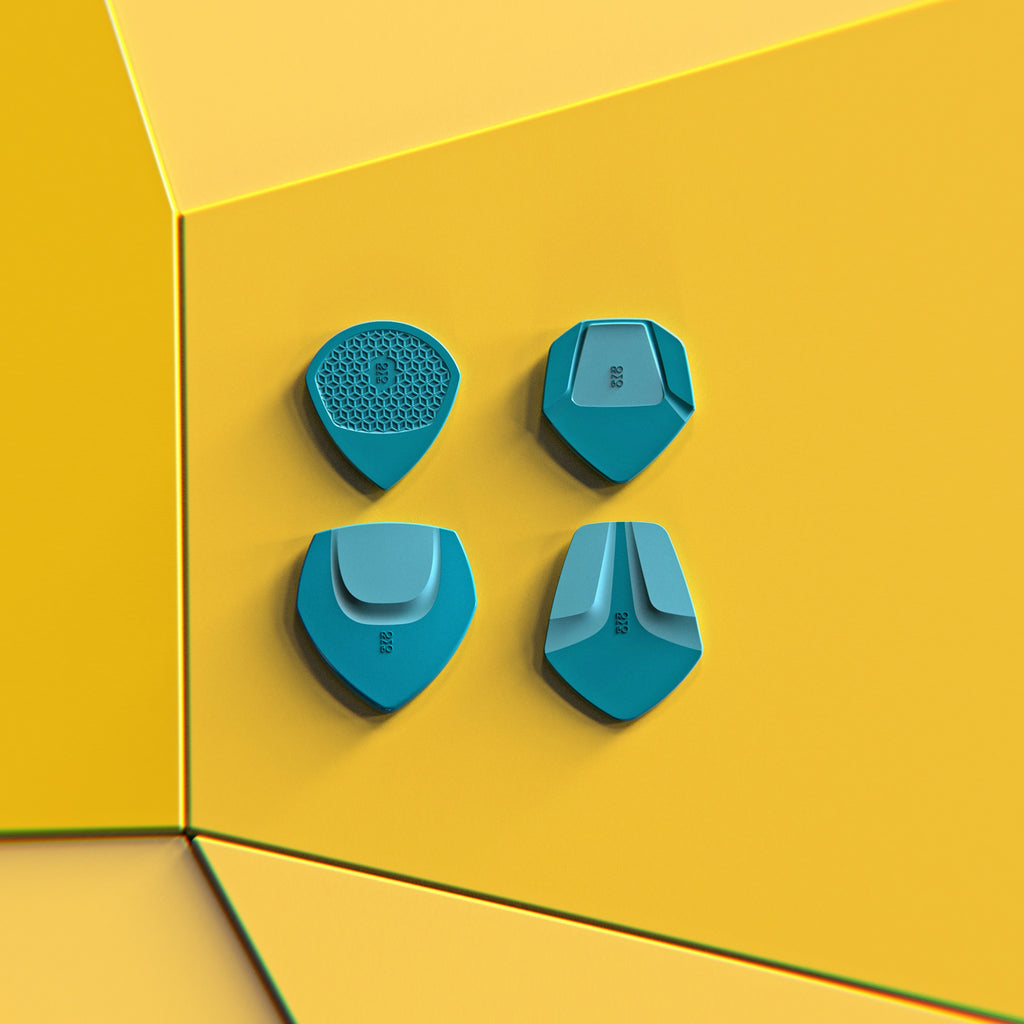
Wir haben uns für den Ansatz entschieden, so viele Gitarristen wie möglich einzubeziehen, um uns beim Co-Design unserer neuen Gitarren-Plektren zu helfen.
Das Ziel dieses Artikels ist es, die Ergebnisse der Umfrage zusammenzufassen, an der 2122 Gitarristen teilgenommen haben. Diese Leute haben das endgültige Design unserer Picks direkt beeinflusst.

Die Gitarren-Community hat Rombo seit seinem Start im Jahr 2019 stark unterstützt.
Wir wollten keine neuen Gitarrenpicks kreieren, ohne die Leute zu fragen, die von Anfang an dabei waren. Sie alle sind der Kern von Rombo, und Sie sollten entscheiden, welche Produkte wir entwickeln.
Der logischste Schritt war, eine große Umfrage zu erstellen, die es der Community ermöglicht, uns mitzuteilen, wie sie ihre Gitarrenplektren gern hätten. Wir glauben, dass dies der einzige Weg ist, ein Produkt zu entwickeln, das auf den Wünschen unserer Community basiert und uns ermöglicht, grundlegende Entscheidungen über die Ausrichtung unseres Unternehmens zu treffen.

Dies ist nur möglich, wenn man auf die Gedanken jedes Gitarristen hört.
GUITAR PICKS 2023 - ERGEBNISSE DER UMFRAGE
2122 Gitarristen haben an der Umfrage teilgenommen und sich somit am Designprozess dieser neuen Gitarren-Plektren für 2023 beteiligt.
509 von ihnen hinterließen eine private Nachricht mit detaillierten Informationen.
Weiter unten gehen wir auf diese Nachrichten ein.

WAS IST IHR LIEBLINGS-GITARREN-PICK-DESIGN?


Es gibt einen klaren Gewinner. Gitarrenplektrum Nummer 2 ist der Favorit für die meisten Teilnehmer.
Könnte es an seiner Ähnlichkeit in Form und Größe mit dem legendären Jazz-III-Gitarrenpick liegen?
Überraschenderweise ist Nummer 4 das Gitarrenplektrum, das mich während des Prototypentests am meisten überrascht hat. Aber natürlich weiß man nie, bis man es probiert hat!
GITARRENPICK NUMMER 1:

Name:
- Mosaic: 33,4%
- Pegasus: 16,6%
- Sense: 13%
- Summit 6,8%
- Andere Namen: 30,2%
Durchschnittliche Dicke: 0,66 mm
Größe: Kleine Größe mit 89 % der Stimmen
GITARRENPICK NUMMER 2:

Name:
- Shell: 42 %
- Lance: 18%
- Turtle: 8,2%
- Andere Namen: 31,8%
Durchschnittliche Dicke: 0,953 mm
Größe: Mittlere Größe mit 77 % der Stimmen
GITARRENPICK NUMMER 3:

Name:
- Erebus: 52%
- Quasar: 32,1%
- Jupiter: 10,1%
- Moon: 5,15%
- Andere Namen: 0,65%
Durchschnittliche Dicke: >2 mm
Größe: Große Größe mit 55 % der Stimmen
GITARRENPICK NUMMER 4:

Name:
- Dune: 39,8%
- Lance: 31,2%
- Doppler:19,6 %
- Sense: 4,7%
- Andere Namen: 4,7%
Durchschnittliche Dicke: 0,72 mm
Größe: Mittlere Größe mit 85 % der Stimmen
GUITAR PICKS: PERSÖNLICHE GEDANKEN VON 509 GITARRENSPIELERN

Insgesamt 509 Personen haben uns eine private Nachricht bezüglich Gitarrenpleks hinterlassen.
Wir haben sie alle sorgfältig gelesen und werden alle diese Informationen während der Entwicklung berücksichtigen.
Hier sind die 10 häufigsten Fragen, die wir wiederholt erhalten haben, und unsere Kommentare dazu:
● Werden die Plektren in verschiedenen Farben erhältlich sein?
Ja! Die Markteinführung umfasst alle regulären Rombo-Farben.
Weitere „Special Edition“-Farben sind in Vorbereitung.
● Werden sie die gleiche Griffstruktur haben?
Viele Leute haben uns E-Mails und Briefe bezüglich der Griffstruktur geschickt. Mit den Mikronoppen haben wir den Vorteil von mittelgriffigen Oberflächen, die viel Kontrolle hinzufügen.
Eine sehr kleine Anzahl von Menschen möchte jedoch, dass die Picks mehr Grip haben. Wir mussten hier eine Entscheidung treffen, und es war schwer. Wir werden die „Korndichte“ auf den strukturierten Bereichen leicht erhöhen, sodass mehr „Micro nodules“ pro Quadratmillimeter entstehen.
Auf diese Weise hoffen wir, den Bedürfnissen aller Gruppen gerecht zu werden.
● Das Material ist kühl, erzeugt aber warme und sanfte Töne. ich bevorzuge
helle Töne. Plant ihr ein neues Materialsortiment?
Wir haben unser Materialkomposition absichtlich geschaffen, um diese sanften Töne zu erreichen. Etwa 12 % der Benutzer gaben jedoch an, helle Töne zu bevorzugen.
Wir haben beschlossen, mit der Forschung an einem neuen Material zu beginnen, das als zusätzliches Sortiment auf den Markt gebracht wird, sobald wir die richtige Formel gefunden haben. Das voraussichtliche Datum für die Markteinführung des neuen Materials ist Anfang 2024.
● Warum erstellt ihr nicht für jedes Plektrum unterschiedliche Dicken?
der Modelle?
Wir möchten, dass jedes Plektrum einzigartig ist. Da jeder Mensch individuelle Vorlieben hat, glauben wir, dass jedes Plektrum sein eigenes Design haben sollte. In Zukunft hoffen wir, eine breitere Palette von Plektrumdesigns erstellen zu können, um jedes mögliche Bedürfnis abzudecken.
● Was ist mit Plektren für Bassisten?
Die meisten unserer Plektren sind mit Bass kompatibel, wie wir bei einigen Bassisten bestätigt haben, die sie regelmäßig verwenden, insbesondere Rombo Diamond und Rombo Origami. Das haben wir HIER erklärt.
● Ihr solltet Merch, T-Shirts und andere Dinge anbieten:
Vielleicht in der Zukunft. Jetzt wollen wir uns zu 100% auf die Entwicklung der Gitarrenpicks konzentrieren. Jede Minute, die wir für das Design eines T-Shirts aufwenden, wird von der Qualität der Picks abgezogen! ;)
● Werdet ihr die EcoBlack-Reihe in anderen Farben anbieten?
Das EcoBlack-Material kann derzeit nur einfarbig produziert werden.
Durch den Recyclingprozess entsteht eine sehr dunkle Pigmentierung. Die Industrie arbeitet hart daran, einen Weg zu finden, neue Recyclingverfahren zu schaffen. Wir hoffen, dass wir in Zukunft alle unsere Plektren aus recyceltem Material herstellen werden.
● Warum erstellet ihr keine Boutique-Picks?
Gegenfrage: Was ist ein Boutique-Plektrum?
Ein Boutique-Plektrum ist ein einzigartiges Kunstwerk in Form eines Plektrums, das ihr zum Gitarrenspielen verwenden könnt. Normalerweise sind diese Plektren handgefertigt und aus exotischen Materialien. Sie enthalten einige künstlerische Elemente wie Ornamentgeometrien und sind in der Regel einzigartige Sondereditionsstücke mit erhöhten Startpreisen.
Unser Ansatz ist ein anderer. Wir kreieren Boutique-ähnliche Gitarren-Pick-Designs zu sehr erschwinglichen Preisen. Andernfalls wären nur ein paar Rombo-Designs für die einflussreichsten Pick-Sammler verfügbar.
Wir glauben, dass wir auf diese Weise eine Nische zwischen Massenproduktions-Picks und einzelnen Sondereditionen gefunden haben. Mit diesem Ansatz bringen wir das Boutique-Feeling zu einer größeren Anzahl von Menschen und stärken die Plektrum-Community und das Bewusstsein für dieses kleine, aber wichtige Accessoire.
● Einige Plektren, die ich 2019 bestellt habe, hatten Grate. Dies ist kein Problem für
spielen, aber es sieht nicht cool aus.
Wir haben gute Nachrichten für Sie. 2021 haben wir eine neue Methode entwickelt, um die Grate manuell von den Plektren zu entfernen. Das bedeutet, dass alle Rombo-Picks manuell überarbeitet und bearbeitet werden, um alle visuellen Aspekte zu entfernen, die nicht zum ursprünglichen Design gehören (wie kleine Grate an der Umrandung).
Dies hat uns zusätzliche Zeit gekostet, aber als Premium-Marke müssen wir unsere Qualitätsstandards ständig verbessern, um sicherzustellen, dass eure Plektren so gut sind, wie ihr es erwartet!
● Warum nochmal Kickstarter?
Siehe unten :)
WANN SIND DIE NEUEN PICKS VERFÜGBAR?
Die neuen Gitarrenpicks kommen im Frühjahr 2023 auf den Markt.
Wenn ihr eine E-Mail erhalten möchtet, sobald die Picks verfügbar sind, abonniert unseren Newsletter (siehe Fußzeile).
Dies ist der Zeitplan, den wir für dieses Projekt erstellt haben:

WARUM KICKSTARTER?
Kickstarter-Kampagnen lassen Träume und Ideen Wirklichkeit werden. Rombo ist immer noch ein kleines Start-up, das von zwei Personen geführt wird und nur begrenzten Zugang zu Ressourcen hat. Über Kickstarter binden wir die Community der Gitarristen ein und zeigen unsere Gitarrenplektren vor dem Start.
Dieser Prozess bringt uns in Kontakt mit den echten Gitarristen. Es zwingt uns, flexibel zu bleiben, Änderungen zu akzeptieren, und es fordert uns heraus, neue Designs zu entwickeln, um die Erwartungen unseres Publikums zu erfüllen.
Wir lieben offene und kritische Kritik, und dies ist der beste Ort dafür, wo alle Kommentare und Gedanken sichtbar sind. Indem wir Ihre Erfahrungen teilen, können wir auf eure Bedürfnisse und Wünsche eingehen und Gitarrenplektren entwickeln, die einen Unterschied machen.

7 Essential Guitar Pick Techniques
One of the most valuable skills when it comes to guitar playing is versatility.
Versatility allows you to adapt to different environments and enriches your playing, making a difference in the final result.
Music is about staying dynamic and monotony kills dynamic. Therefore, the most logical step for you as a guitarist is to expand your repertoire of guitar skills to keep that vital, engaging sound that makes music so joyful.
If you have decided to use a guitar pick for playing guitar, there are seven techniques that are a must.
They will take time to learn and master, but believe me, they make the difference.

1- TREMOLO PICKING:
If you have listened to the music of the last 70 years, you can probably recognize this guitar technique in most rock classic hits.
Tremolo is an Italian word which means “to shake” or “to tremble”.
In the context of guitar, it involves striking one (sometimes more than one) guitar string very fast with alternating strokes. Therefore, this technique is a form of alternate picking. Tremolo picking is very easy to learn but it requires strong discipline and practice to master.
Tremolo picking is essentially useful for any style of music and obviously a big part of the surf guitar sound (I’m a big fan of it!).

In guitar literature, sometimes the words tremolo and vibrato are reversed. This technique has nothing to do with a “tremolo bar” or a "tremolo effects box".
WHY IS TREMOLO PICKING IMPORTANT?
If one of your long-term goals in your guitar learning process is to increase speed, tremolo picking is a good place to start.
It is not only very fun but also can add new textures and some dynamics to your compositions. You would be surprised how well this technique fits even in metal or hardcore music.
A FAMOUS SONG WITH TREMOLO PICKING:
The surf rock version of the song “Misirlou”, from Dick Dale, is probably the greatest example of tremolo picking. The original one is a traditional song from the Eastern Mediterranean area dating back to 1927!
The version of Dick Dale got very popular after appearing in the soundtrack of Pulp Fiction in 1994.
BEST PICK FOR TREMOLO PICKING:
The most influential factors when choosing the best guitar pick for tremolo picking are thickness, material, and grip.
It’s important to have a snappy, responsive guitar pick. For this, medium picks with a medium/pointy tip are my recommendation.
However, there is no consensus in the guitar world for this. Many players have reported preferring thick, rigid picks.
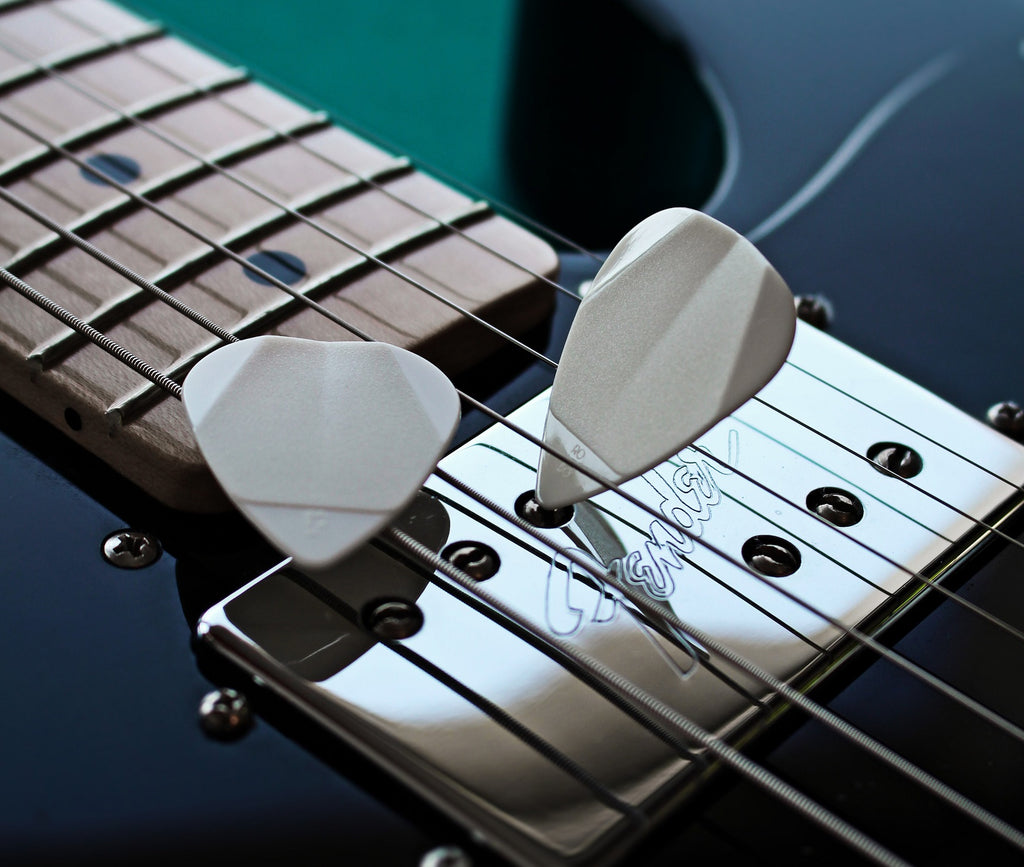
In my case, I have found the best stability and speed using Rombo Origami. This pick can be described as: Flexible but still rigid enough for note control. Right amount of flexibility for a snappy fluid attack that's bright and crisp. The concave surface on the hold area ensures an ergonomic and comfortable hold.
Everyone’s hand is a little different in how they hold the pick and move. The best way to find out is to test different shapes and thicknesses, and then try them out
Good luck!
2- PICK SLIDES:
One very extended technique often performed in the rock, metal, and punk genres is pick slides or pick scrapes.
By holding the edge of the guitar pick against the guitar strings and moving it along the edge, the pick catches the strings’ windings, causing the strings to vibrate and produce a very pleasant textured noise.
Usually, guitar pick slides start near the bridge and end over the higher frets. However, there are countless variations of pick slides depending on the direction, the angle of the pick relative to the strings, and other variables.

Unfortunately, performing pick slides completely ruins the edges of the guitar pick, especially on thinner ones. This won’t directly affect the tone or control of the plectrum, but the damaged sides will develop some dents.
What makes a guitar pick durable? Find our here.
WHY ARE PICK SLIDES IMPORTANT?
Guitar pick slides are not the most relevant aspect of your playing. Nevertheless, a correctly performed slide in the right place will add so much to the moment.

The noisy textures produced by this technique are the perfect weapon of choice for songs using high distortion levels.
A FAMOUS SONG WITH PICK SLIDES:
The first use of the pick slide is attributed to Bo Diddley and can be heard in the opening of his song "Road Runner" from the 60s.
Today, some guitarists have taken this technique to a new level and have created signature variations. A shining example of pick slides from the last years is the metal band Gojira with their famous signature “Gojira-Scrape” that was created by accident and combines several guitar pick techniques
BEST PICK FOR PICK SLIDES:
If you are going to do pick slides frequently, then you need to consider two things:
- Using durable guitar pick materials, and
- Using thick picks.
Otherwise, your guitar picks will be inoperative after a couple of sessions. The dilemma is that most players get better noisy sounds with a medium guitar pick.

I have found a solution that works for me: medium-heavy picks that are large enough to scrape with higher areas of the pick that won’t touch the strings. From our picks, I prefer Rombo Horizon the most for pick slides. Also, the curvy edge creates different pressure on different strings and that’s nice.
3- PINCH HARMONICS:
Do you know any guitar player who does not like pinch harmonics? I do not either.
Pinch harmonics are created by the picking hand. Playing this technique produces high-pitched tones. This phenomenon occurs when you stop a part of the string vibrations in the right position and create a "node".

There is a simple way to test this; pick a note and apply a small pressure anywhere on the string such that the vibration doesn’t stop completely.
WHY ARE PINCH HARMONICS IMPORTANT?
Pinch harmonics are often related to high gain tones and metal music but they are a powerful tool to add dynamics and textures to any genre of music or type of guitar; electric or acoustic.
It is considered one of the most abstruse techniques for intermediate players. Common problems are pinch harmonics that aren't loud enough or additional noises that make the harmonics not sound clean enough.

Root causes of this problem can be:
-
the guitar player does not know the right places on the strings to play pinch harmonics
-
there is unwanted noise coming from unmuted strings
-
the pinch harmonic is produced isolated, without combining it with other techniques like vibrato.
Most guitar players (including me) played their first pinch harmonic accidentally.
A FAMOUS SONG WITH PINCH HARMONICS:
Guitarist Billy Gibbons from ZZ Top is considered the father of pinch harmonics. Not because he invented them, but because he brought them to the mainstream. Although he is a well-rounded guitarist with a focused skillset based on blues, he is best known for his pinch harmonics.
BEST PICK FOR PINCH HARMONICS:
There is no special pick to do pinch harmonics. The pinch harmonic is technically produced by the thumb of your picking hand.
However, this technique is widely used in lead guitar in combination with other advanced techniques that work especially well with thick, small guitar picks.
Therefore, although you can learn pinch harmonics using thin picks, I recommend using thick picks.
 #If you want to learn more about the differences between thin and thick guitar picks read our article "Thick guitar picks vs thin guitar picks".
#If you want to learn more about the differences between thin and thick guitar picks read our article "Thick guitar picks vs thin guitar picks".
4- PALM MUTE:
Palm mute is a very regular technique used by most guitarists. By placing the side of the picking hand on the strings close to the bridge and dampening the guitar strings (when necessary), the strings produce muted sounds.
You can control the dampening effect by moving your hand to a different position further from the bridge.

Although this technique isn't seen as a very difficult one, these are common mistakes that prevent players from learning it properly:
- wrong hand position
- not having a relaxed posture
- problems by keeping a stable tempo
- too much pressure on the strings
WHY IS PALM MUTE IMPORTANT?
As a guitarist or bassist, you are always on the lookout to make your music sound natural, creative, and exciting.
Palm-muting is a great skill for dynamic control exercises. This means you will automatically learn how to shape your sound using fluctuations in volume and intensity.
With this skill in your repertoire, your music will sound more vocal and dynamic.
A FAMOUS SONG WITH PALM MUTE:
This technique is very old. As old as the invention of the electric guitar (1936). Most classical players have been using it for centuries with all kinds of instruments.
Today, palm muting is widely used in heavy metal, thrash, speed, and death metal. It is often found in music that features distortion effects.
Is there any good song to practice palm muting for getting better at it? “Master of Puppets” from Metallica—it’s a masterclass in palm muting and down picking.
BEST PICK FOR PALM MUTE:
I recommend using a thick guitar pick for this. They provide high volume, a broader dynamic range, and more control over single notes (in case you use palm mute arpeggios). In addition, palm muting is a demanding technique that causes a lot of guitar pick wear. As you might know, thick guitar picks are more durable.

My favorite choice for this technique is Rombo Diamond.
5- PICK STRUMMING:
Guitar pick strumming is a way of playing guitar. A strum is a sweeping action where a pick (or finger!) brushes over the guitar strings and generates sounds.
For most guitar players, this is the first technique they learned and the technique that caused most headaches as a beginner.

Learning how to strum correctly takes time and practice. Most beginners lack the necessary muscle memory it takes to play while remaining relaxed or having a good posture.
WHY IS PICK STRUMMING IMPORTANT?
In many ways, understanding this skill is essential for understanding guitar. Great strumming skills mean being a great rhythm guitarist. Therefore, this should be your number one goal as a beginner.
Learning chords is important, but they are just static shapes. The diversity of the hundreds (if not thousands) of strumming patterns available will inject musicality and rhythm into your playing.
A FAMOUS SONG WITH PICK STRUMMING:
“Bad moon rising” by Creedence Clearwater Revival, is a good place to start. It combines easy chords (D, A, G) with a very simple progression and a very catchy, bluesy melody.
BEST PICK FOR STRUMMING:
My best advice for beginners is to start with a very thin guitar pick. It can help to practice with something below 0.6 that’s nice and bendy. As you improve your skills, you can try with thicker picks, as they will add more bass to your tone.

For all the beginners out there, my best choice would be Rombo Classic.
However, if you are in the very beginning of your guitar journey, please read this article where I explain, why starting with medium guitar picks can be a better choice for you. "Medium Gauge Guitar Picks".
6- DOWNPICKING
Downpicking or down-stroke picking is a very beloved guitar technique in which the player moves the guitar pick only in a downward motion. The tip of the pick does not brush the strings as the hand moves back to the original position for the next down-stroke.
It is one of the most underrated skills on guitar and although performing this technique might seem easy, the required endurance for long passages with fast tempo is very often a problem even for advanced guitarists.

WHY IS DOWNPICKING IMPORTANT?
But first, why would you want to remove the upstrokes (alternate picking) and then increase the necessary effort for the same number of strokes? Why would you torture your wrist muscles in this way?
This technique is widely used in metal and punk guitar and the main reason is that when mastered, downpicking can make the guitar’s sound very powerful and rhythmic.
A FAMOUS SONG WITH DOWNPICKING:
Famous punk guitarist Johnny Ramone used this technique in the mid-70s in combination with fast tempo (180 to 200 bpm). The technique was very innovative at that time and influenced many current guitarists like James Hetfield who has been regarded as “the King of Downpicking”.
Many beginner guitarists start with songs from Ramones because of their simplicity in terms of chords and lack of tempo variations.
BEST PICK FOR DOWNPICKING:
For downpicking, there is a basic rule: the more mass the guitar pick has, the thicker and more aggressive the sound.

Therefore, a thick, large guitar pick with a pointy tip will be the loudest and most rhythmic one.
I recommend Rombo Diamond.
7- HYBRID PICKING
The interesting thing about hybrid picking is the fact that the player uses a plectrum as well as one or more fingers. This can be done alternately or simultaneously.
Typical styles for this technique are rockabilly guitar, country and bluegrass, and more classical passages with acoustic or classical guitar.
Hybrid picking can be very hard if you are a beginner. Before you think of learning this technique, you will have to learn how to play with your fingers and with a guitar pick. This is a requirement you cannot avoid.

WHY IS HYBRID PICKING IMPORTANT:
Three major arguments should convince you to learn hybrid picking:
Tone diversity:
The pick is generally used to play bass notes with a longer duration and very noticeable timbral differences caused by variations in the vibration of the strings. Therefore, your playing will sound more interesting combining pick and fingers.
Timing:
Hybrid picking allows you to pick two to four strings simultaneously. This makes it very different from strumming and gives an approach much more similar to piano techniques.
Flexibility:
Managing this technique, you will be able to change between fingerstyle playing and guitar pick playing within the same song or passage.
A FAMOUS SONG WITH HYBRID PICKING:
Hybrid picking was popularized by guitarists like Steve Howe some decades ago. Most players that learn this technique today start with a more classical approach.
A great song to start with this technique is “Amy” by Tommy Emmanuel. However, the complexity of the chords makes this song only possible to play for intermediate and advanced players.
BEST PICK FOR HYBRID PICKING:
There is no such thing as a “good” or “bad” pick for hybrid picking. You can use the pick you think fits the best for the song you are playing.
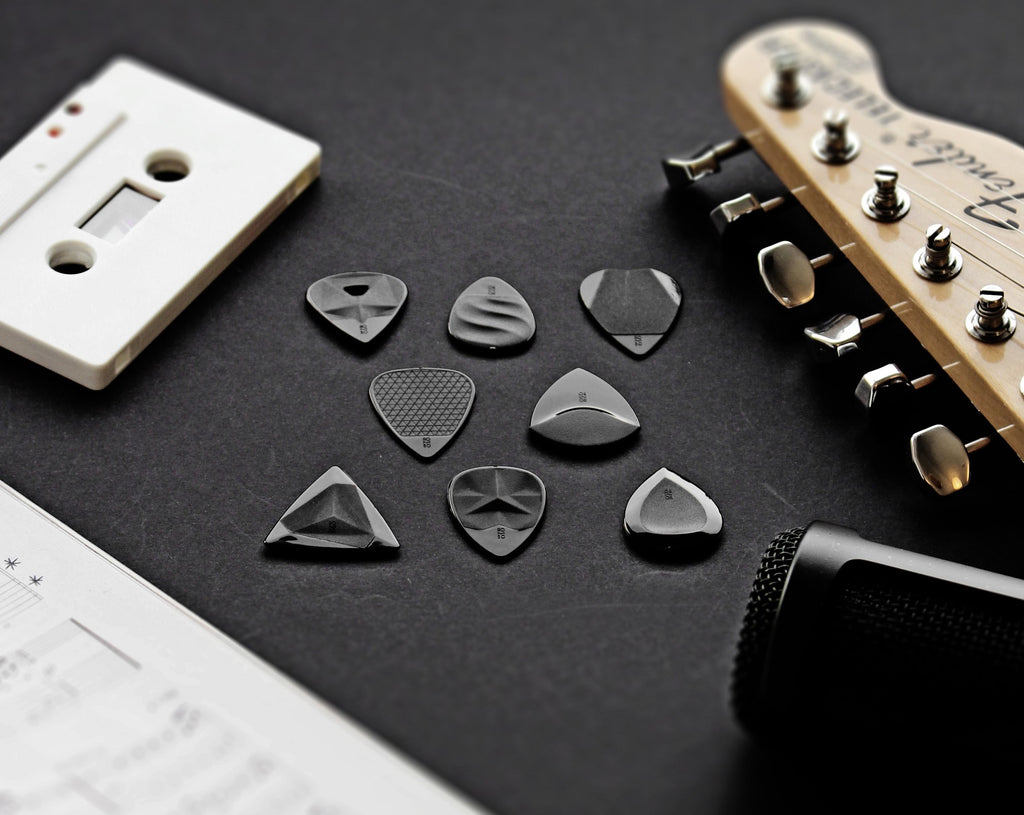
Because this technique is widely used by rhythm guitarists, there is a consensus that picks around 1 mm will perform well. However, it is up to you to try and decide which one is best for every passage.
Discover more about guitar pick thickness here.
8- BONUS SKILL – SWEEP PICKING:
For some reason, sweep picking is the trend. Every guitar forum gets new threads with this topic week after week. Perhaps it’s due to the high speed and visually nice arpeggios that make the guitar produce cyclical sound patterns and put us in a status of trance.

This technique describes the action of playing single notes on consecutive strings using the same motion, either all down-strokes or all upstrokes.
Sweep picking has been recognized as a difficult technique. It is more for advanced players and it can take years to master it.
WHY IS SWEEP PICKING IMPORTANT?
Sweep picking is used by guitarists to play arpeggios at high speed. The phrasing sounds produced by this technique sounds typical of other instruments like the piano.
Although sweep picking is a very important technique for building speed and fluency on string instruments, my advice would be to not learn this technique unless you have mastered other techniques that can give you more versatility.
Sure, it is ok to use sweep picking occasionally but that is not what you are going to play most of the time. In my opinion, a lot of bands overuse this technique. Therefore, you should reflect if the time needed to correctly learn sweep picking could be used for other more relevant skills.
A FAMOUS SONG WITH SWEEP PICKING:
Although often regarded as a “modern guitar technique”, pick sweeping has been around since the 50s. The technique was first used and developed by jazz guitarists.
Today, it is commonly used in metal but many students start with the song “Give Me the Night” by George Benson. Practicing sweep picking with clean tones can help you develop a more accurate technique.
BEST PICK FOR SWEEP PICKING:
What qualities are you looking for in a pick to perform sweep picking? Small and easy to handle, good maneuverability and stability, and good string separation. This means: Thick, pointy guitar picks like Jade or Horizon.

However, I have a bonus for you: We have received some E-Mails from professional guitarists using Rombo Prisma for their sweeping techniques, a pick that wasn’t developed for this. However, its sharp tip, combined with a very large, beveled edge, and the total “mass” of the pick (variable thickness), makes this pick a great candidate for bright tonal sweep picking solos.


Guitar Pick Deep Analysis: Rombo Diamond
Guitar picks can be found in all shapes, colors, and materials. These small items used for specific guitar techniques can offer different tones, dynamic ranges, and ergonomics, and therefore create a totally different playing experience depending on the pick you use.
The aim of this series of articles is to inform you in detail in a way that you wouldn’t find anywhere else. We want you to understand why we do what we do. So relax, hold your tea, and enjoy our first deep analysis on the guitar pick Rombo Diamond.
1 - Guitar pick Rombo Diamond: Overview

Exceptional picking control and accuracy. Favorite amongst advanced guitarists. The hole in the middle provides extra control and grip rate. Sharp tip for high attack, and clean bright tones.
2 - Guitar Pick Geometry Analysis
Guitar pick size
With its 28,4 x 25,5 mm, Rombo diamond can be considered a small-medium sized guitar pick.
Small guitar picks have several advantages: They perform exceptionally when practicing speed and are perfect for shred techniques.
With small-sized plectrums, your fingers are closer to the strings and you get more feedback from your guitar playing.
The downside of these picks is that they can be dropped easily. This is the reason we decided to increase the size of Rombo Diamond a little bit and make it small-medium. The first prototype was only 25 mm high.

Furthermore, we decided to increase the width to match the regular size of a thumb.
Guitar pick shape
The shape of a guitar pick is often overlooked. However, in the case of Rombo Diamond, thanks to its form and the pointy guitar pick tip, the attack and the control are substantially increased.
The pointy guitar pick tip, with only 3 mm in diameter, was designed to provide maximum note control.



The angle of the tip is wide enough to let your guitar strings slide longer.
Rombo Diamond has a slight bevel edge, mainly used to increase the guitar playing speed.
With a rounded bevel like this, the attack of the guitar pick gets smoother, a feature that changes the feedback you receive when you use specific techniques.
This is only possible for guitar picks with enough thickness, and it is very popular because of the feeling of easiness it provides while playing guitar.
Guitar pick thickness and guitar pick flexibility
The guitar pick thickness mainly defines how flexible a guitar pick is. However, other aspects like tone and ergonomics are mostly influenced by the thickness of the pick.
Rombo Diamond has guitar pick variable thickness along its body. This means that this guitar pick has different thicknesses for the hold area and for the tip area.

The thickness of the tip is 1,35 mm, providing enough space for the bevel edge mentioned before. This can be considered as a heavy/thick guitar pick.
The thickness of the hold area varies due to the diamond design. At the highest point, right in the middle where all the vertices create the diamond design, it is 2,65 mm thick.
The variable thickness on Rombo Diamond has been implemented primarily for two reasons:
It increases the feeling of control because the pick is easier to hold
It increases the bass tones, creating a much thicker tone
Both dimensions create a very rigid guitar pick.
The thickness of a guitar pick is also an essential factor in terms of durability. The shape and bevel combined with the polished tip and its thickness make this pick very durable.
3 - Guitar pick Materials and Surfaces
Guitar pick material
The material of a guitar pick is strictly connected to its flexibility and tone.
Rombo Diamond is offered in the Rombo polymer and the EcoBlack polymer, which offer the same characteristics.
The polymer we use is an improved variation of nylon designed to increase the durability and cause some tone changes. It is manufactured in Italy.

Since we use the same material for all our guitar picks, this part of the analysis will be skipped. We have already created an extended article regarding the materials that can be found here.
Guitar pick design
The Guitar Pick design is obviously inspired by a diamond shaped geometry. Rombo Diamond was meant to be hard, durable and rigid, therefore this design matches its mechanical attributes very well.
The functional surfaces were distributed in a way to enhance the diamond form. The grip area in the middle makes the diamond visible, while the polished areas give the shape and tip more optical clarity.

As we will see in the next chapter, the 3D surfaces were designed as functional surfaces to improve the grip. However, with the first prototypes, we realized that this was a very nice way to explore more design nuances.
Guitar pick grip
For the grip of Rombo Diamond, there are three aspects to consider:
The material
The 3D Geometry The micro-nodules texture
The micronodules texture is the texture we developed to create a comfortable grip. Usually, this texture wouldn’t be enough for a good grip and for this reason, we incremented the grip using the right material and 3D surfaces.
The 3D surfaces with the shape of a diamond have different thicknesses and tilted angles that fold the surface in different directions. This increases the grip substantially and avoids the rotation of the pick while playing.
For the people who like to hold the pick on the back side, we created a tunnel to compensate for the thickness reduction this area has.

We consider Rombo Diamond to be a pick with medium grip.
Guitar pick colors
Currently Rombo Diamond is offered in the following colors.

Manufacturing technique
Rombo Diamond is manufactured using an engineering technology called injection molding, in which melted polymers are forced to fill a mold and get a specific shape.
After that, there is a small mark called “the gate” in the back of the pick, which is where the melted material flows through to enter the mould. After the production, this manufacturing mark is treated by hand to make it smaller and less visible.
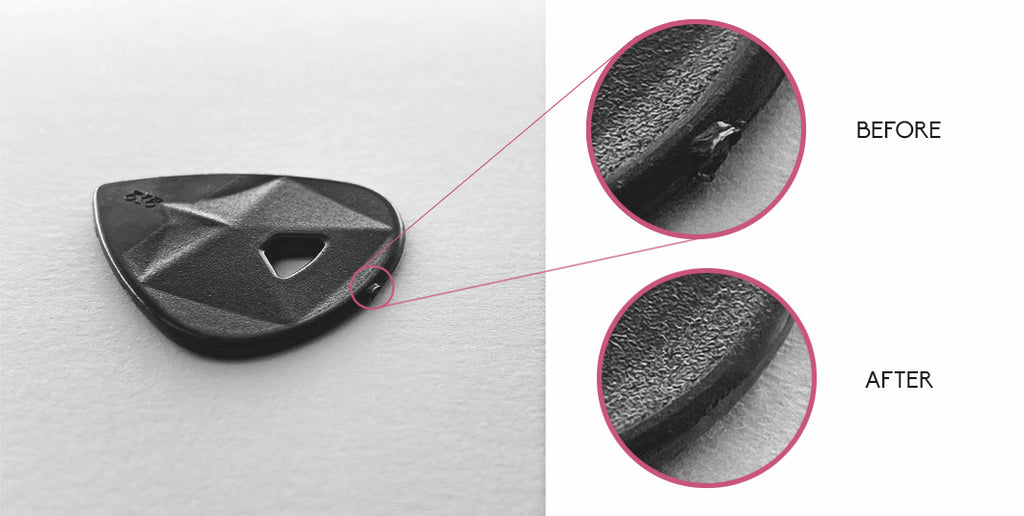
The borders of the pick have a parting line which is also removed post-production to increase the quality of the borders of the guitar pick.

Rombo Diamond is manufactured by automatic processes. However, a post treatment by hand is necessary to achieve the quality Rombo pursues.
4 - Guitar pick sound
Guitar Pick tone
So far, we have defined Rombo Diamond as a very thick, small-medium guitar pick, with a sharp tip. These are the typical characteristics of a pick that produces very bright tones.
However, due to the variable thickness mentioned before, we incremented the dynamic range of the guitar pick, allowing the player to enjoy some bass dark tones as well.
Usually, guitar picks with a very heavy attack can reduce the sustain of your guitar tone. With these small thickness changes we solved this problem.
The polished guitar pick tip, combined with its shape, enhances the bright tones and allows you to play some of the harmonic techniques on an electric guitar more easily.
The bevel edge can create those beautiful thick and compressed tones that we all like for distortion and overdrive.
Rombo Diamond is a pick that produces bright and clear tones, but with slightly dark shades in the background, which makes the sound richer and more complete.
Guitar Pick Noise
Because of the integrated bevel edge, the material toughness, the shape, the pointy polished tip, and the thickness, we consider Rombo Diamond to be a guitar pick that creates lower pick noise.

5 - Guitar pick techniques
Rombo Diamond was designed for the advanced player who likes speed, volume, attack, and control, but still wants a sophisticated tone and more than just power.
It is mainly intended for electric guitars.
Arpeggios and shred techniques like sweep, alternate, and tremolo picking are good examples of techniques which can be improved using the right guitar picks.
For strumming and palm mute, using Rombo Diamond can give you a much thicker and complete sound creating a bigger atmosphere when playing guitar.
6 - Pricing
Rombo Diamond is currently offered only in guitar pick sets containing four guitar picks in different color combinations and a packaging card with extra information about the pick attributes.
This pick is also included in the Variety Pack from Rombo, with other guitar pick models.
7 - Conclusion
Size: Small-Medium
Shape: Pointy tip, sharp attack angle
Thickness: Heavy with variable thickness. Hold area: 2,65 mm - Attack area: 1,35 mm
Materials: Rombo Polymer and EcoBlack
Durability: Very high
Design: Diamond Design with two different surface types.
Grip: Medium, micro-nodules combined with 3D Surfaces
Colors available: Graphite Black, Water Blue, Strawberry Red, Honey Yellow, EcoBlack
Manufacturing technique: Injection moulding and hand processing of the borders.
Tone: Bright, clear tones with a bass nuance on the background caused by the geometry.
Pick noise: Low
Techniques: Mostly electric guitar. Lead guitar techniques and high volume distortion.
Pricing: Guitar Pick Set Rombo Diamond

Guitar Picks Online - 9 main Advantages of ordering Guitar Picks Online
But, why do guitar players order guitar picks online? What are the advantages of ordering picks online?
We have thought about this recently and have summarized the main 9 advantages of ordering guitar picks online.
1 - There is a huge variety of guitar picks available online
1 - There is a huge variety of guitar picks available online
There are lots of guitar pick makers (like us) using their knowledge to create guitar picks that differ a lot from common guitar picks or mass production guitar picks.
The aim of these guitar pick makers is to create something unique with a specific purpose and to show their work to the world. Where can you find these people?

2 - More information and detailed Descriptions for the Guitar Picks
However, in most online shops for guitar picks, the product pages show you everything you need to know.
Usually they display a couple of pictures of the guitar picks, inform about the guitar pick material, the thickness, the shape, and they include a detailed description of the plectrum and its features.
In our case, we use pictures like this to condensate all the information:

Nevertheless, we care a lot about packaging and want you to have this information in your hands as well

You can visit online guitar pick websites and compare products. This will make you a more educated customer that can take decisions based on facts. It will make you reflect on your guitar playing style and which necessities your guitar pick should cover.
3 - Personal Contact with the Guitar Pick Makers
It is as easy as sending an e-mail or a PM on Instagram, and you will be talking directly to us, the founders.

In the social media era, small start-ups manage their own profiles by themselves. I have had great conversations with customers from all over the world about guitar picks! We receive lots of questions every week and try to answer every private message. So far, I think we have answered 100% of the messages, or at least I have tried!
Regarding this point: not only the customer profits from this, but also the guitar pick maker, who gets to know the customer in a more detailed way and becomes aware of the problems to solve.
A few months ago, I talked to a customer who had purchased his guitar pick Rombo Diamond back in July 2019, directly from our first campaign on Kickstarter. After a year of playing daily, he made a new order and sent us a picture of the new pick vs. the old one.

That was amazing! It was a great feeling to know that somebody had spent so much time with a product we have developed and that it still worked! Also, I wonder how he could keep the pick for so many months without losing it!
4 - Guitar Pick reviews are Gold!
Depending on how old you are, you probably remember the time when purchasing goods on the internet was a surprise: you wouldn't know if the product was of good quality until it arrived.
It is very easy to find guitar pick reviews online, sometimes even on Youtube. These reviews can help you a lot. Especially if the product page of the guitar picks is missing some important information, like in the following this example, a review “Jan” left on Rombo Origami:

Now, let’s suppose you want to purchase Rombo Diamond for your bass because of its guitar pick thickness. Maybe after reading this review you change your opinion!
5 - Reviews can trigger Changes in the Design of Guitar Picks
This point is connected to the previous one.
Considering that the founders read the reviews, and they can have direct influence on the product, the best idea you can have is to tell them what points you like/don’t like.
We have a very good example here in a review from Matt Samuel on the Guitar Pick Holder:

We received this review on the Guitar Pick Holder some weeks ago. After a couple of small workshops together, we have now designed a packaging, which we hope to implement in a couple of months.
A simple action like this can have a big impact on the product you will get! Thanks for that, Matt Samuel!
6 - Your Wishes will be fulfilled!
In our big survey from June 2020, 1552 guitarists were able to choose the names of our new guitar picks. We had some ideas for their names, but two users offered a new fresh source of inspiration when they decided to give their input and suggest new names.
Rombo Horizon and Rombo Jade were suggested at the beginning of the survey by random users and the votes kept rolling in for those names. Two days later, these names were the winners and more customers kept voting for them until the survey finished. We will be using these names as soon as the guitar picks are launched in 2021. These two unknown participants are heros for us!

Some weeks ago we received an e-mail from a customer that said: “Hey guys, you should create a special edition of your guitar pick Rombo Origami in the color white, like paper origami”.
How cool is that? Of course we will do that sometime in the future, it is such a great idea! I can already visualize the packaging with different white tones and the white guitar picks on it and I just feel extremely happy to have such a great guitar community around Rombo picks.
7 - Online Guitar Pick Stores are open 24/7
You can visit the stores anytime from your couch or while you commute in the metro. That’s quite practical!

8 - Very easy to ship!
Guitar picks are very small pieces of gear and they fit in a small envelope. This means, you don’t even need to be at home to get them delivered because they fit in your mailing box.

One of the best advantages of such small products is that they are very adequate for surprising your friends. Imagine you come home after a long day, you open the mailbox and find a strange letter on it containing a couple of cool guitar picks. That probably feels very good! This is one of the reasons we created the gift boxes.
9 - New Guitar Gear for the Price of a Starbucks Coffee
Let’s admit it, sometimes we - guitarists - just want to shop a little bit and have a couple of new experiences trying new gear.
If you feel like this and don’t feel like spending much money, guitar picks are a very good option. Guitar picks are the loudest amplifier in our hands and will have a direct influence on the tone our guitars produce! Therefore, why not try lots of them and use them for different purposes?
In our article Guitar Picks for Beginners we talked about the importance of having at least 3 favorite guitar picks. Let’s go find them!

7 Wege, um Plektrumgeräusche zu vermeiden
Plektrumgeräusche lassen sich nicht ganz vermeiden. Insbesondere bei der Aufnahme von Akustikgitarren neigen Plektren dazu, viele Klick- und Klackgeräusche und Geräusche zu erzeugen, die dein Spielerlebnis sowie das deiner Zuhörer ruinieren kann.
Beim Gitarre lernen, wirst du einen Punkt erreichen, an dem du dich auf die Übertragung von Emotionen, das wirkungsvolle Spielen und eine bessere dynamische Kontrolle konzentrieren möchtest.
Um Gitarrentechniken zu meistern, musst du jeden Ton, der von der Gitarre erzeugt wird, vollständig kontrollieren: beabsichtigte und unbeabsichtigte.

Ich persönlich denke, dass Plektrumgeräusche ein Teil des Gitarrenspiels sind, und ich genieße sogar einige Vintage-Aufnahmen, bei denen das Plektrumgeräusch fast absichtlich vorhanden zu sein scheint. In den meisten Fällen möchtest du es jedoch beseitigen.
Wir haben alle Tipps und Tricks zusammengefasst, von denen wir glauben, dass sie dir helfen können, die Geräusche beim Spielen mit einem Plektrum zu reduzieren.
1- Halte das Plektrum mit weniger Spannung
Gitarrenpicks erzeugen beim Zupfen/Anschlagen der Saiten Geräusche. Wenn du dein Plektrum lockerer hältst, hilft das sehr, da deine Finger einen Teil der Energie absorbieren, wenn das Plektrum auf die Saiten trifft.
Wir haben einen Artikel mit dem Titel „Wie man ein Gitarrenplektrum hält“ veröffentlicht, der alles enthält, was du wissen musst, um diesen Trick zu meistern.

Beim Aufnehmen kann es hilfreich sein, dein Instrument im Verhältnis zu den anderen etwas lauter zu machen. Dies ist eine in Studios übliche Methode, die den Gitarristen hilft, sich zu entspannen.
Egal, ob du eine Studio-Session, einen Jam mit deinen Freunden oder einige Solo-Relax-Sessions zu Hause planen, ein bewusstes Aufwärmen vor dem Gitarre spielen ist Pflichtprogramm.

2- Probieren verschiedene Winkel beim Anschlagen aus
Der Winkel des Plektrums im Verhältnis zu den Saiten ist das am meisten diskutierte Element, wenn es um Plektrumgeräusche geht.
Grundsätzlich gilt: Je weniger Plektrum mit den Gitarrensaiten in Kontakt kommt, desto weniger Lärm erzeugt es. Deshalb winkle das Plektrum leicht zu den Saiten an.
Probiere verschiedene Winkel beim Anschlagen und Zupfen aus. Dies erfordert eine bewusste Anpassung deinerseits, aber sobald du es gemeistert hast, kannst du den Anschlag des Picks leichter variieren.
Abhängig vom verwendeten Plektrum, dem Musikstil und den Gitarrentechniken, die du verwendest, und deinem Können, benötigst du einen anderen Anschlagwinkel. Konzentriere dich also 30 Minuten darauf, den besten für dich zu finden, und gewöhne dich daran, diesen zu spielen.
3- Ist deine Schlagkraft passend?
Manchmal spielt man und der Flow setzt ein, man verlässt gedanklich den Raum und betritt „die Zone“, diesen schönen Ort, an dem man besser klingt als sonst.
Wir gehen so sehr in die Musik hinein, dass wir natürlich härter zuschlagen.

Übermäßige Anschlagkraft ist eine der häufigsten Ursachen für Plektrumgeräusche. Darüber hinaus kann es das Sustain abwürgen und dazu führen, dass die von dir gespielten Noten auf viel weniger natürliche Weise ausklingen.
4- Nylon-Gitarrenpicks sind weniger laut
Das Material der Gitarren-Plektren beeinflusst nicht nur den Ton, sondern auch das Geräusch, das das Plektrum erzeugt.
Nylon gilt als eine der am wenigsten lauten Formeln, wenn es um industrielle Materialien geht, die für Gitarrenpicks verwendet werden.
Dies liegt an der Zähigkeit dieser Mischung, die dank ihrer mechanischen Eigenschaften starke Stöße effizient absorbieren kann.

Bei Rombo verwenden wir eine modifizierte Version von Nylon, die für zusätzliche Haltbarkeit sorgt und die Lebensdauer der Plektren verlängert. Dies war notwendig, da Gitarrenpicks aus Nylon sehr schnell verschleißen. Hier erfährst du mehr über die Materialien.
Wenn du dir nicht sicher bist, ob du das richtige Plektrum verwenden, ist ein Variety-Paket eine gute Option, das Gitarrenpicks mit unterschiedlichen Attributen enthält. Dies ist eine gute Möglichkeit, mehrere Picks zu testen und deine Entwicklung zu verfolgen, während du beginnst, deine Fähigkeiten für jedes einzelne Plektrum zu verbessern.
5- Die richtige Dicke des Plektrums
Als Faustregel kann man sagen, dass schwerere Plektren weniger laut sind, was irgendwie widersprüchlich klingt. Aber warum ist das so?

Die Verwendung sehr dünner Plektren in Kombination mit schnellem Spiel, wie Strumming, führt dazu, dass sich die Plektren verbiegen, wenn sie die Gitarrensaiten verlassen, wodurch eine Art Klickgeräusch entsteht. Dies geschieht besonders beim Spielen von Akustikgitarren, da der Korpus der Gitarre als Verstärker für diesen Klang fungiert.
Schwerere Plektren lassen jede Saite ihren eigenen Ton ohne viele Begleitgeräusche erzeugen.

Die variable Dicke, die in allen unseren Gitarrenplektren enthalten ist, verbessert nicht nur die Kontrolle, sondern reduziert auch das Rauschen. Der Körper des Plektrums ist dicker und steifer, während die Spitze dünner und flexibler ist. Mit diesem Merkmal wird die Gesamtflexibilität der Spitze verringert, während ihre ursprüngliche Dicke und ihr ursprüngliches Material beibehalten werden. Das bedeutet mehr Kontrolle und weniger Lärm.
Dicke vs. dünne Plektren. In diesem Artikel besprechen wir alle Aspekte, die einen Unterschied machen.
6- Eine abgeschrägte Kante kann helfen, das Pickgeräusch zu reduzieren
Plektren mit einer abgeschrägten Kante gleiten besser und verursachen weniger Geräusche. In Kombination mit dem bereits erwähnten Anschlagwinkel können sie dir dabei helfen, das Plektrumgeräusch stark zu reduzieren.
Auch die Form und Größe des Plektrums sind wichtig, aber das ist eher eine Frage der Präferenz.

7- Reduziere Plektrumgeräusche mit einem Plektrum mit polierter Spitze
Wir haben häufig darüber gesprochen, welchen Einfluss eine polierte Spitze auf den Ton und die Haltbarkeit eines Gitarrenpickels hat.
Eine polierte Spitze gleitet auch ganz leicht über den Rand der Gitarrensaite. Auf der anderen Seite erzeugen Gitarrenplektren mit einer raueren Textur an der Spitze eine stärkere Höhenwiedergabe, selbst wenn sie am Rand gespielt werden. Dies passiert auch, wenn die Picks beginnen, sich abzunutzen.

Einige puristische Gitarristen bevorzugen jedoch, wie am Anfang des Artikels erwähnt, das Plektrum sogar, um Geräusche zu erzeugen, und haben es extra in ihre Aufnahmen eingebaut.
Bonus: Nimm dich sich selbst auf
Sehr erfahrene Live-Spieler, die nicht viel Studioerfahrung haben, reflektieren manchmal nicht genug über all die kleinen Nuancen ihres Spiels.

Eine gute Übung, um dies zu vermeiden, ist sich selbst aufzunehmen. Es ist erstaunlich, wie viel wir verpassen, wenn wir in die Zone kommen. Du wirst beim Anhören deiner Tracks Plektrengeräusche bemerken und es ist viel einfacher, kritische Bereiche zu identifizieren, als während des Spielens.
Wenn du Akustikgitarre spielst, versuche, das/die Mikrofon(e) an verschiedenen Orten zu platzieren, du wirst feststellen, wie viel Unterschied es in Bezug auf das Plektrumgeräusch machen kann.
Abschluss
Wir können Plektrengeräusche nicht vollständig eliminieren, aber es gibt genug zu tun, um unser Spiel zu verbessern und es erheblich zu reduzieren.
Der beste Weg, Plektrumgeräusche zu reduzieren, besteht darin, sich dessen bewusst zu sein und über dein Spiel nachzudenken, um deine Fähigkeiten zu verbessern und verschiedene Plektren für verschiedene Stile und Gitarrentypen auszuprobieren.
Wenn du eine neue Möglichkeit entdeckst, den Plektrum-Lärm zu reduzieren, lass es uns bitte wissen, damit wir es in den Artikel aufnehmen können!

Inside Rombo Guitar Picks: Guitar Picks developed and engineered in Germany
This article was created because you asked for it. It is meant to be as transparent as possible, so that you can see who the faces behind Rombo are and how we organize this project internally.
We hope you enjoy it!
Rombo Guitar Picks: Short Introduction
Since 2019, Rombo has been researching surface finish and design in order to find the perfect balance between grip, ergonomics, and function in guitar picks and other guitar accessories. Rombo was born thanks to an amazing guitar player community whose aim is to continue this adventure and quest for the perfect guitar accessories.
Who are the faces behind Rombo Guitar Picks?
We are Judith and Carlos, a happily married couple trying to innovate in the world of guitar picks. We live near Stuttgart, Germany.

We both love music, guitars, product development, challenges, and attention to detail, so Rombo was the perfect excuse to mix all these things together and have some amazing adventures.
Our location in Remseck a.N., Germany
Packing and shipping of our guitar picks
From Remseck, near Stuttgart in Germany, we do almost everything.
Here, we receive the packaging and the dots we use to fix the guitar picks to the packaging. We try to be very organized and keep the place very tidy. Tidy places also look better for photographs!

In the shipping station, there is one tray for every guitar pick model. We also include a flyer and a “thank you”-card with every delivery. This way we make the experience more personal, while sharing our journey of packing your guitar picks directly with you!

We have a label printer, which is super useful, and thankfully our web system allows us to automate the printing for every customer and create a label with just one click.
Our post carrier receives the boxes from us with all the information they need to bring our products to you, including weight, countries, and import information for the customs.

We ship every order directly from our location.
The envelopes we use are not very cheap, but they protect the product well, they are made of 100% recycled paper and they are plastic free.

Always learning something new
We have to be very multifaceted to cover all the tasks we do, from idea generation, product development, graphic design, photography, web maintenance, logistics, social media, packaging development, and accounting, to all the stuff a start-up involves.

We believe that doing everything by ourselves gives us a very close perspective from the customer side.
This means, when you ask something on Instagram or Facebook, you receive an e-mail from us, or we answer your comment. It is us behind the screen typing every word and every smiley!

We love walking a lot. We go for a walk for 5 kilometres almost everyday. Almost every idea we applied to Rombo was created while having a walk. We called it our daily inspiration walk.

Rombo is a long journey
Two years ago, at the very beginning of this journey, we could not have imagined how many things we needed to learn!
We have encountered many challenges on the way; for example, I remember it was very difficult to find out how to sell internationally and establish a system that is fast enough for us.

I cannot tell how many books on startups, online marketing, Kickstarter or time management we have read! One of the most useful ones was A Crowdfunder's Strategy Guide: Build a Better Business by Building Community, by Jamey Stegmeier.
A funny anecdote is that Judith and I don’t have our own Instagram profiles. For the first post from Rombo, we had to check out a tutorial on Youtube to try to understand the process. I am glad to say that two years later, we have reached almost 20K followers!
PS: We still don’t have our own accounts, the one for Rombo is enough work! :)
Guitar picks: All about the design process
The most complex part is the design process of a guitar pick.
I like to sketch a lot, so I have lots of old ideas and sketches which I use as an inspiration source. Sometimes, we use questions to challenge the design process, like “Is it possible to create a guitar pick that is flexible and rigid at the same time?” While trying to answer this question, we came up with the idea of “variable thickness”, which has proven to substantially increase ergonomics.

Since we have an engineering & design background, we also do the modeling in 3D and product engineering. Every detail is important here to create high-quality products.

When we think the design is ready, we create some prototypes and send them to the testers. If you follow us on social media you will know some of the testers from our stories.
In total, we have about 30 guitar players that help us during this phase of the project and communicate with us which points they liked or didn’t like. Thanks to their feedback, we are able to improve areas of the guitar picks which we would otherwise not have thought of.
Manufacturing technologies
For the manufacturing of our guitar picks on a large scale, we use a technology called injection molding.

In this process, the melted raw material is injected into a mold with the negative shape of the guitar picks.
It is a very complex process with lots of engineering in it, the material has to be treated in a special way to keep the proper humidity, temperature and pressure, and to avoid external contaminations.

On the left, the injection mould from Rombo Diamond: Our polimer flows through the mould runner (yellow arrows) after it reaches over 270°C degrees and it is pushed forward.
The red area is the area we use for the grip texture. The blue area is high mirror polished.
On the right: The first ever produced Rombo Origami from 30.11.2018. The first 50 guitar picks we produced were sent to guitar pick testers who gave us feedback about the material, the grip, the tone and the shape.
The raw material we use is produced in Italy. We have worked very closely with our material partner to accomplish every requirement we had, including the 100% recycled material of the EcoBlack sets. If you want to know more about the materials we are using, you can find more information HERE.

Packaging for guitar picks
We believe packaging is a very important aspect of a product. We not only use it to create an atmosphere and emphasize the quality of the product, but also to inform you about the attributes of our guitar picks.

This is the reason we created packaging with lots of printable areas to describe the guitar picks. We include our parameter bars, a short description of the guitar pick, the 6 special attributes of a Rombo guitar pick, and a QR-code with extra information.
We had a total of about 6 different concepts before we decided which one was the most suitable.
Right now, we are creating the packaging layouts for the new models that will launch in 2021. We have received some samples and they look great!


If you want to see the new models, you can click HERE.
Guitar picks and social media:
Rombo product photography:
Carlos takes the pictures for social media. We are not very skilled with the camera, but we have learned a couple of tricks and after thousands of trials, we are able to take decent pictures in our living room.

In our Instagram you can find the best pictures.
Educating the customer
You have probably noticed that our posts on Instagram are mainly informative. Guitar picks are often underrated and most guitar players don’t think much about it.
However, guitar picks are the loudest amplifier you can have in your hands and are the bridge between you and your guitar.

We try to pass the know-how we have obtained directly to you, so you can make conscious decisions about the products you purchase. Aspects like the variations on the tone depending on guitar pick thickness, or why are there so many guitar pick shapes and materials… And this is the reason we created our blog articles.
Our aim is to create a communication process that goes back and forth between us. Some of you have become friends of ours and have won a new perspective of thinking about guitar picks.
Engagement of the community
“To listen closely and reply well is the highest perfection we are able to attain in the art of conversation.” – François de La Rochefoucauld, essayist.
We believe we have one of the most engaged communities ever! We try to answer every comment and every private message, and we are sure we have an answer rate very close to 100%.
You all have participated in surveys, and you have left amazing comments and reviews. You post stories regularly and we have had very deep conversations with some of you! Thank you!
We also received great support from many amazing blogs like Heavy Repping, Gigs and Guitars, The Gadget Flow, Ultimate-Guitar, Guitar World, and others.
Rombo around the world
Rombo is expanding. We are working with dealers around the world and currently we have sellers in the following countries:

This means, with the help of our dealers we are able to sell in Europe, North America, Asia, Australia, almost every country of South America, and South Africa.
Transparent communication with our dealers is a priority with us, and so far 100% of the new sellers stay with us! Together we are developing the brand and taking it to the next step.
The future of rombo:
During our inspiration walks, we talk about Rombo in the next few years. It is very difficult to imagine what the future will bring.
We would like to bring new designs (lots of them!), to increase the amount of recycled material for the manufacturing of the picks, or even be able to create colored recycled guitar picks. We want to talk more to our customers and share our experiences, and from time to time, share some great music and playlists.
We are only two people and every step takes its time. Some of you have written beautiful thank you letters to us or left very good reviews and we want to let you know that we are working hard everyday not to disappoint you :)
You are the best and you have a vote on the future of Rombo!

New guitar picks for 2021 - How over 1500 guitar players helped us co-design our guitar picks:
In May 2020, Judith and I had finished the first 3D sketches of our four new guitar pick models. However, the picks weren’t 100% ready.
The thickness, the size, and even the names of the picks were still undefined.

We decided to take a new approach and involve as many guitarists as possible to help us co-create our new guitar picks.
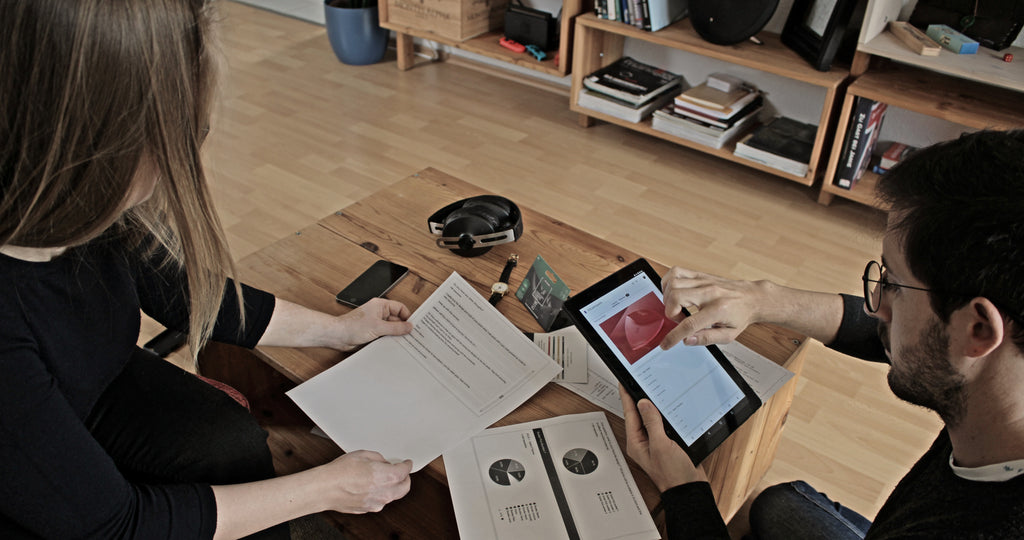
What is a signature guitar pick:
Signature guitar picks are common in the guitar pick world.
These picks were developed with the help of some expert and famous guitarists from a specific music field.
From our point of view, this is a very narrow design path that only considers the opinion and guitar playing style of one person.
Our approach: The opposite of a signature pick:
The guitar community has strongly supported Rombopicks since its beginning in 2019.
We did not want to create new guitar picks without asking the people who have been with us since the beginning. You guys and girls are the core of Rombo, and you should decide which products we develop.
The most logical step was to create a big survey to allow users to tell us how they prefer their guitar picks.
We think this is the only way to develop our guitar picks, based on the wants of our users, allowing us to make essential decisions about our company's direction.

This is only possible by listening to the thoughts of every guitar player.
In addition, by asking precise questions about guitar picks, we are able to create more awareness of complex issues, like: Why are guitar picks thick or thin? How they behave when the size changes? Does the flexibility of a guitar pick affect the tone? What about the material?
When the user is aware of the product features, he/she can deliver a useful vote.
Since the beginning, we have been researching all these areas and are sharing them with you. With every article about plectrums we have written, we have contributed to the knowledge you have about your gear so you will be able to decide which gear is the best for you and understand why.
The results of the survey:
Participants:
1.552 guitar players (including us) have participated in the survey and therefore have took part in the design process of these new guitar picks for 2021.
336 of them left a private message with detailed information.

What is your favorite guitar pick design?
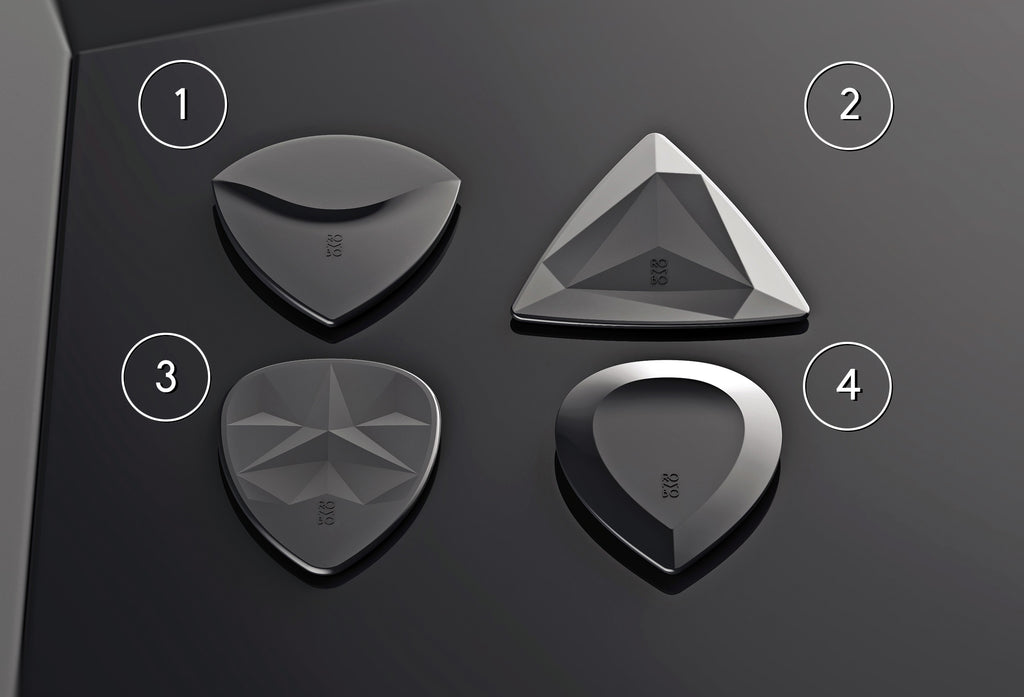
Pick number1: 18,8%
Pick number 2: 14,8%
Pick number 3: 27,8%
Pick number 4: 38,7%
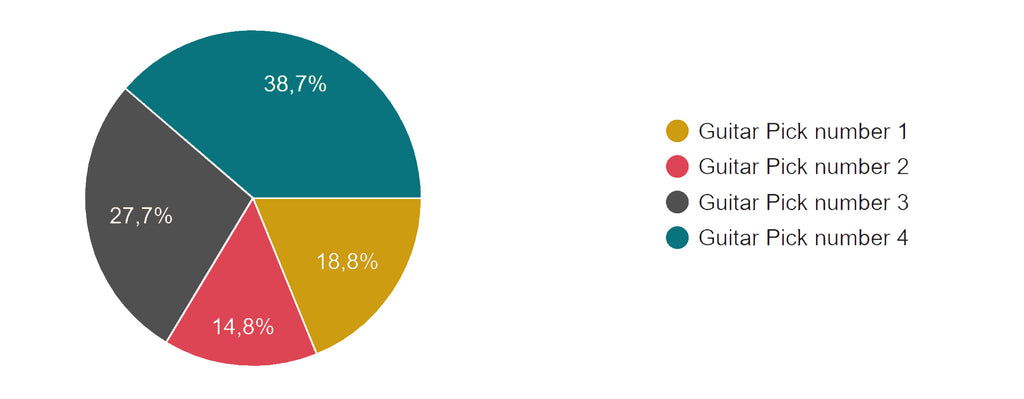
Guitar Pick Number 1:

Name:
Rombo Horizon: 34,5%
Rombo Sense. 33,9%
Rombo Summit: 14,1%
Rombo Mood: 7%
Other names: 10,5%
Average Thickness: 1,378 mm
Average Size: Medium Size with 71% of the votes
Guitar Pick Number 2:

Name:
Rombo Prisma: 76%
Rombo Spin: 7,7%
Rombo Treble: 8,4%
Other names: 7,9%
Average Thickness: 0,831 mm
Average Size: Large Size with 73,5% of the votes
Guitar Pick Number 3:

Name:
Rombo Crisp: 47%
Rombo Split: 22,1%
Rombo Prisma: 16,4%
Other names: 14,5%
Average Thickness: 1,028 mm
Average Size: Medium Size with 59,7% of the votes
Guitar Pick Number 4:

Name:
Rombo Jade: 33%
Rombo Shift: 17,6%
Rombo Slope: 12%
Rombo Summit: 10%
Rombo Dune: 7%
Rombo Cascade: 7%
Rombo Wizzard: 4,9%
Other names: 8,5%
Average Thickness: 2,37 mm
Average Size: Small Size with 56,6% of the votes
Guitar picks: Personal thoughts of 336 guitar players

A total of 336 people left us a private message regarding guitar picks.
We have read all of them carefully and we will use all this information during the development.
Here are the important questions we have received and our comments to them:
-
Will the guitar picks be available in new colors?
Not at the moment. However, we are thinking about creating some additional colors for special editions in the future.
-
Will they have the same grip structure?
Yes! Definitely. Lots of people have sent us e-mails and letters regarding the grip structure. With the micro-nodules, we have the advantage of medium-grip surfaces which add lots of control.
However, a very small number of people want the picks to have more grip. We had to make a decision here, and it was hard.
We won’t forget this topic: In the future, we want to develop a texture with more grip for these players.
-
Why don’t you create different guitar pick thicknesses for each one of the models?
We want every guitar pick to be unique. As every person has unique preferences, we believe every guitar pick should have its own design.
In the future, we hope to be able to create a bigger quantity of different plectrum designs to cover each possible necessity.
-
What about picks for bass players?
Most our picks are compatible with bass, as we have confirmed this with some bassists that are using them regularly, especially Rombo Diamond ad Rombo Origami. We explained this HERE.
-
You should create some merch, T-Shirts and other stuff:
Maybe in the future. Now, we want to focus 100% on the development of the guitar picks. Every minute we spend on the design of a T-Shirt will be taken away from the quality of the picks! ;)
-
Will you offer the EcoBlack range in other colors?
The EcoBlack material can only be produced in one color at the moment. The recycling process creates a very dark pigmentation. The industry is working hard to find a way to create new recycling processes. We hope we will manufacture all of our picks out of recycled material in the future.
When will be the new picks available?

The new guitar picks will be available in early 2021.
If you want to receive an E-Mail as soon as the picks are availabe, join our mailing list below on the footer.
This is the timeline we created for this project:
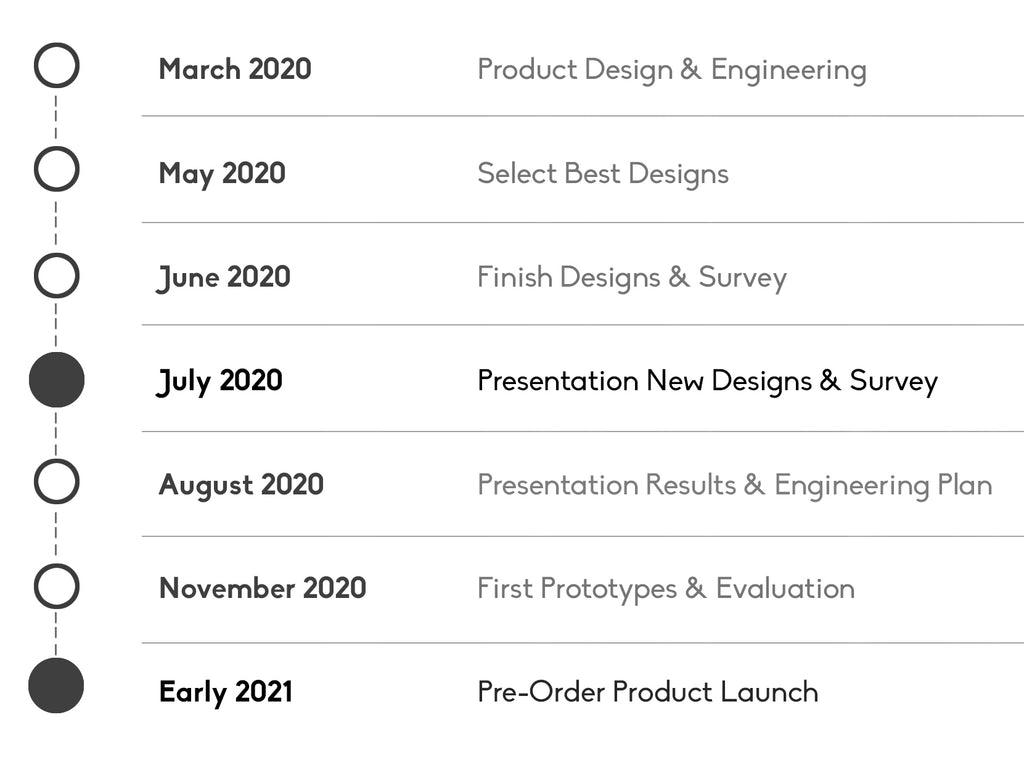
The pre-order product launch will be on the platform Kickstarter (like the first generation of Rombo guitar picks we launched in January 2019).
However, the current development of the Covid-19 could postpone the project a couple of months. We want to launch the product when we are able to deliver worldwide.
Why Kickstarter?
Kickstarter campaigns turn dreams and ideas into reality. Rombo is still a small start-up run by two people, and with limited access to resources. Through Kickstarter, we involve the community of guitar players, showing our guitar picks before launching.
This process brings us in contact with the real guitar players and their necessities. It forces us to remain flexible, accept changes, and challenges us to create new designs to fulfill the expectations of our audience.
We love open and critical criticism, and this is the best place to get it, where all comments and thoughts are visible. By sharing your experiences, we can listen to your needs and wishes, and create guitar picks that make a difference.

Guitar Pick Durability: Everything You Need To Know
The guitar pick has been in constant evolution since the 1920s.
Today, 100 years later, we have achieved great accomplishments in the area of durability of this very important piece of guitar gear.
In this article, we will review all the important points that can cause picks to wear out, and summarize all you need to know about guitar pick durability.
We will make some comments on the tone, to help control the changes, which happen after a guitar pick has worn down.
In addition, we will give some advice to keep your picks “healthier“, longer than expected.
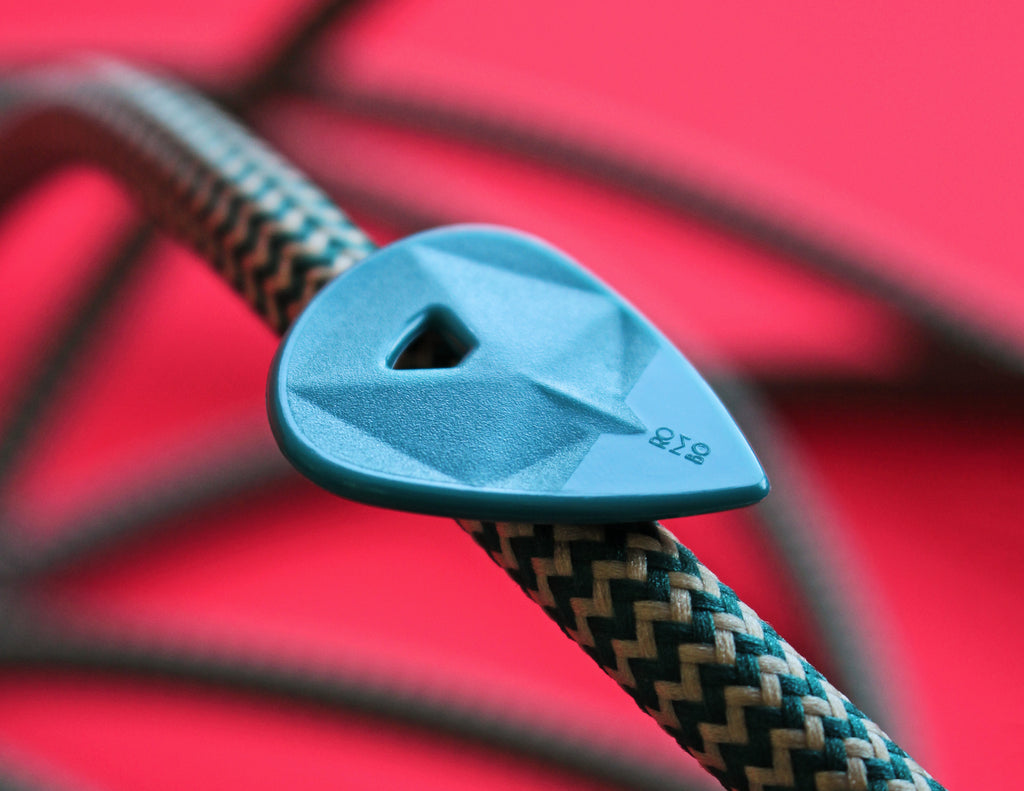
New vs. Old (worn down) Guitar Picks: Tone Changes
We all know that using different guitar picks, will also make a difference in your tone, and your playing. Material, shape, thickness and shape of the pick, directly affect the tone and playability.
Most standard plectrums can resist heavy strumming for a long time, without much wear and tear.
The first thing you may notice after using a guitar pick for some weeks, is that the tip is not as pointy as the new guitar pick. You will see it, and you will hear it, because the tone of the pick will change over time, with wear.


The rounded shape of the worn down plectrum, will create warmer tones, and feel darker. This is totally fine, if this is the tone you are looking for.
It will also affect the way your plectrum plucks the strings:

Just like the guitar strings, the frets, & other components, the guitar picks will wear out over time.
Some players feel a lack of control after the guitar pick has worn down, while others use the rounder picks because of the tone they produce. This especially happens to jazz guitarists, who tend to choose picks that are almost circular, for example: Rombo Waves.
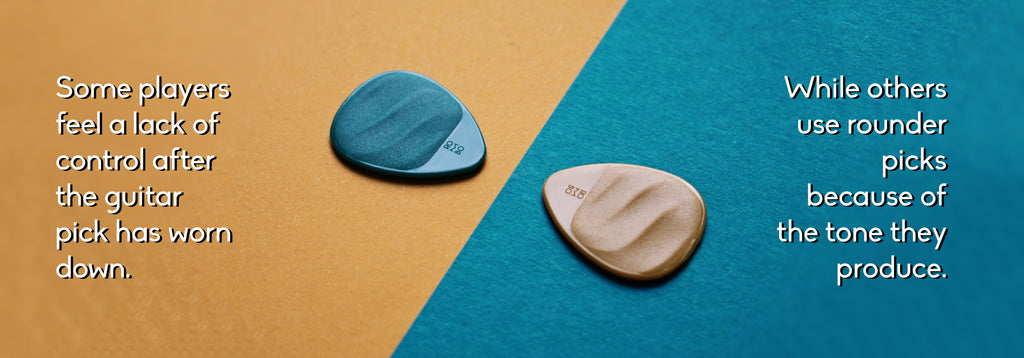
Gaining control when using rounder guitar picks, is an ability you can train yourself to do, and improve.
Why Can’t Picks Last Forever?
Guitar strings are usually made from a mix of steel, nickel, bronze, or brass. In other words: Metals.
Since most players use some kind of plastic material for their guitar picks, (nylon, delrin, …), it’s not surprising that friction between strings and picks will cause the guitar picks to wear down.
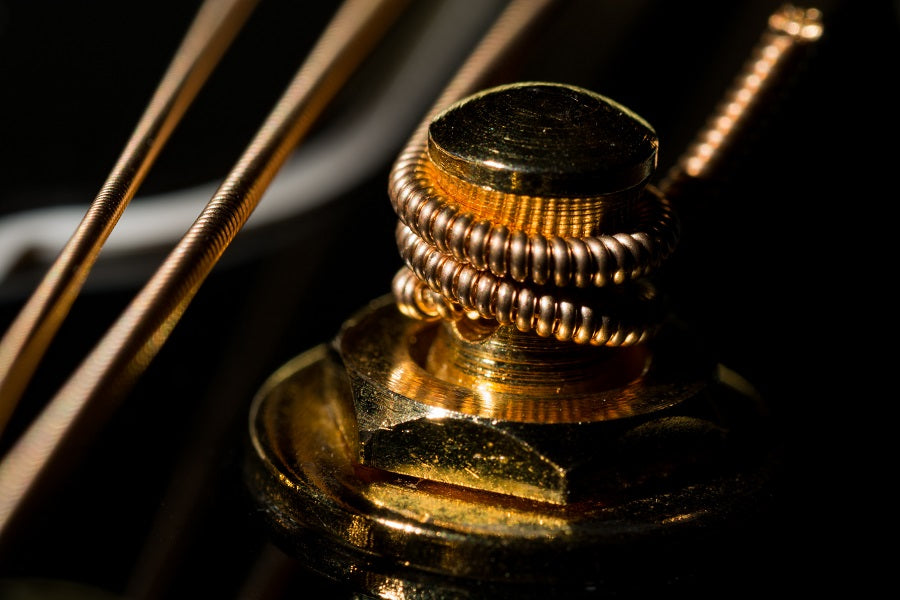
You will notice, the thickest guitar strings have a spiral wire wrapped-around, acting like a sanding file on the plectrum.
Guitar Pick Durability: How Long Should a Guitar Pick Last?
The short answer: If you are an average user, your picks should last a few weeks to a month. If you are a professional player, using specific techniques, like heavy picking and strumming, it will probably last just one day, especially if you are a studio musician recording new tracks every day.
The long answer: This answer includes many factors including guitar pick attributes, and external factors, regardless of the guitar pick you are using. We discuss all of them below.
Guitar Pick Attributes That Directly Affect the Durability
The attributes that define the durability of a guitar pick are as follows:
- Guitar Pick Material
- Guitar Pick Thickness
- Guitar Pick Tip Shape
- Guitar Pick Tip Texture
Harder materials will wear down slower. This is one of the reasons there has been a lot of research in the area of suitable materials for guitar picks.
The goal is to find a wear-resistant material, that keeps the tone characteristics that guitar players want, while still giving a good grip.
However, material is not all. The thickness of a guitar pick will enormously affect the wear and tear. Thinner picks will wear down almost immediately when using heavy pick techniques.

Other attributes of the pick that affect the durability, are the Tip Shape, and the Tip Texture. Very pointed guitar tips tend to wear down faster, because there is less material on the tip.
However, this problem can be partially solved with the right guitar pick tip texture. A polished tip on the guitar pick will cause less friction between strings and plectrum. This is one of the most underrated attributes of a guitar pick, and you can find more information HERE.
What Damages the Pick the Most?
Results show, that the best way of altering and degrading the shape of your plectrums is to perform “pick slides”.
This guitar technique will wear away the edges of your plectrum and will make it useless very quickly.
This won’t directly affect the tone or control of the plectrum, but the damaged sides will contain some dents. The plectrum will get stuck either on the up stroke or the down stroke.
External Factors Which Indirectly Affect the Durability
It’s not only the guitar pick quality that is responsible for its‘ damage. There are three more factors that can play a role on the durability:
- Hours of guitar training
- Guitar strings gauge
- Guitar playing style and used techniques
It is a very simple equation: The more hours you practice, the more your picks will get damaged.
Thicker guitar strings will increase the area of contact with your plectrum, and therefore, wear it down much faster.
Aggressive guitar playing techniques, like fast palm mute, or pick slides, will damage your guitar pick very easily.
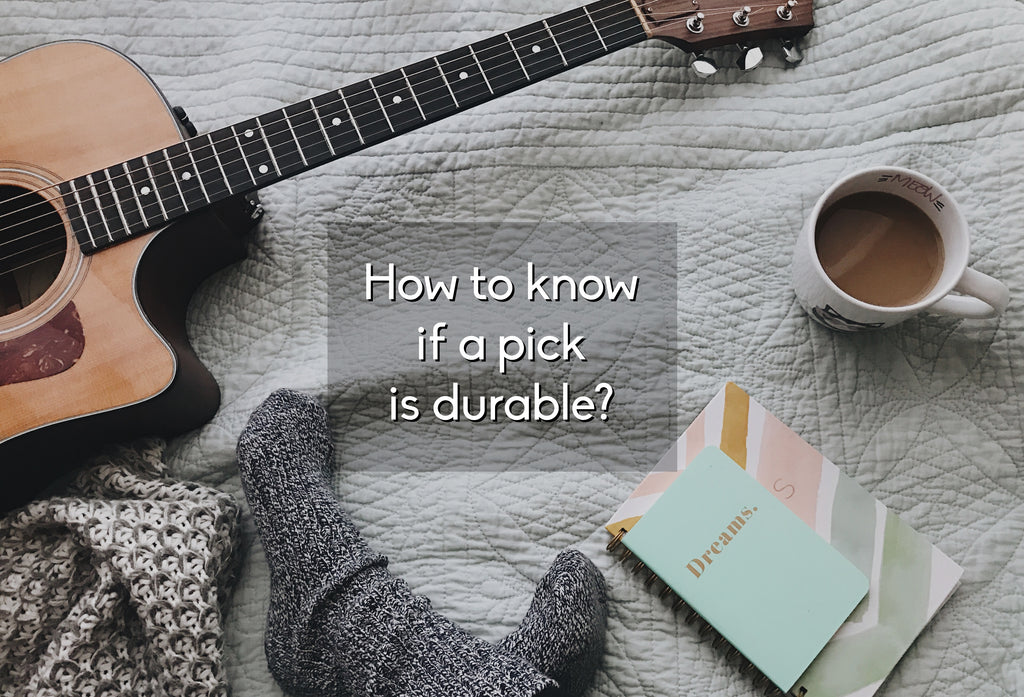
How to know if a Pick is Durable?
The best way to find out, is to test it, and make your own judgment.
You can take advice of expert players, who have tested lots of guitar picks. However, if their playing styles differ from yours, this information won’t help much.
Besides, many expert players have not changed their picks for decades, and they might be missing the material improvements of the last decade.
As mentioned, not only is durability a factor to take into account when choosing a guitar pick, but also the tone and the ergonomics (grip, size,...).
How to Know When to Replace Your Pick?
If the edges of your pick are becoming more rounded, you might start to consider purchasing a new one.
However, never throw away your worn-down guitar picks! The rounded edges can be used to create more mellow tones, and you might want these for some of your songs.
One of the most important things about playing the guitar, is to keep your mind open to new tones and styles. This is the reason some guitar picks have rounded tips even when they are new.
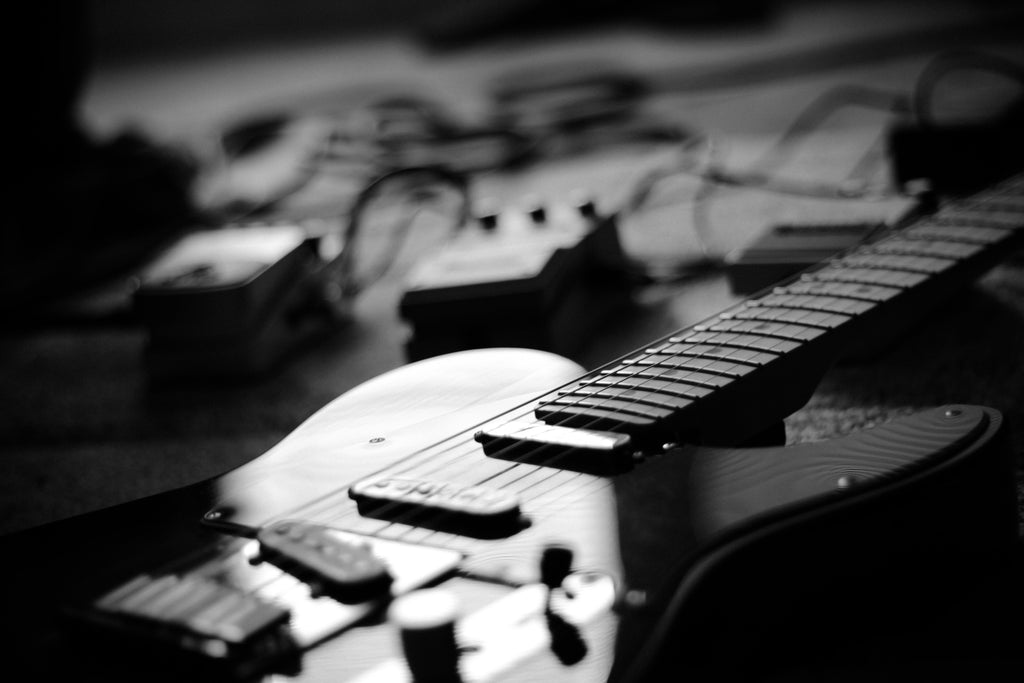
In addition, you can store your old guitar picks in a box. I wish I still had my first guitar pick, that I used, when I was learned to play guitar as a child. A guitar pick can be a beautiful piece of your past.
Check Your Pick Condition Regularly
A tip from my side, is to double check every guitar pick before going out on stage, or studio. A visual inspection is fine.
Always keep some unused plectrums aside. Considering plectrums are probably the least expensive gear of your complete guitar rig, constant wear and tear issues is not a thing you should worry about.
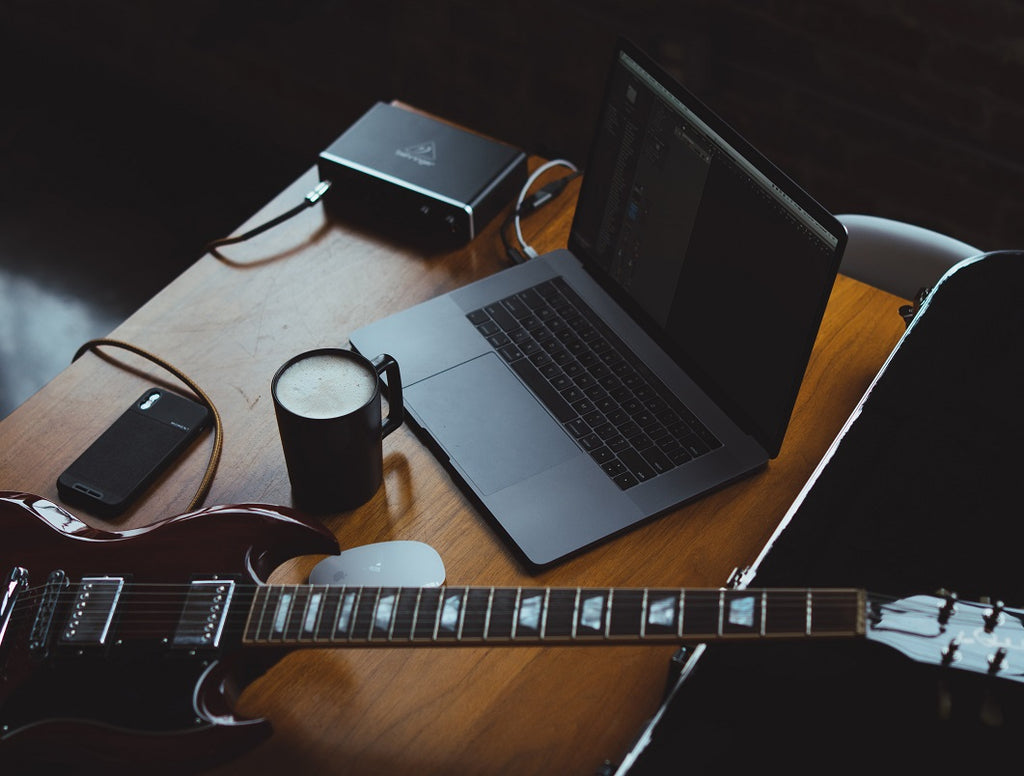
Choose your ideal Plectrum
Are you using the right pick? This is a question you should ask yourself every time you play a song.
Some players have their 5-favourites, depending on the style and type of guitar they want to play.
The most important factors when choosing the right plectrum for you hinges on….
- Material
- Shape
- Thickness
- Size
- Playing style
- Your personal preference
We created a guide that will help you find the right plectrum for you.
You can find it HERE.
Thank you!
The support we are getting from the guitar community makes us very happy!
We, (Carlos and Judith), are really doing our best to create the best guitar picks for you.
If you consider supporting a small family start-up, you can share this article and directly have an influence on our online visibility.
These small actions have helped us since January 2019, and we count on your support! :)

Thanks!

Picks vs. Fingers for Playing Bass Guitar
You have probably heard this question many times: Should I use a pick or my fingers to play bass? You can find a huge amount of different answers on the Internet and still be confused.
My philosophy is, to never limit yourself. Both methods are valid and appropriate for the right musical context.
Picks vs. Fingers: The Eternal Debate
Whether using picks or using your fingers, each technique has its place and, ideally, you need to feel comfortable with either one you choose.
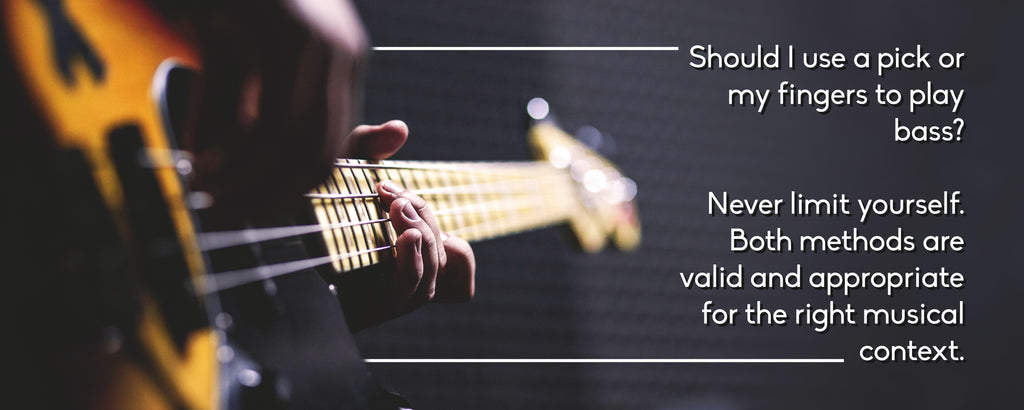
Is there a wrong way to play an instrument? Any method you use to get sound out of your instrument - fingers, pick, nails, palms of your hands, etc - can work, if the sound produced is the sound you are looking for. It is entirely a matter of personal preferences.
Therefore, this is an unimportant debate, if your plan is to be a versatile musician, and be able to understand the rich parts of every bass line, regardless of the method used to play them.
For me, it is difficult to understand how this debate has been one of the most controversial topics since the advent of modern music creation decades ago.
Why not keep an open mind and become comfortable with both methods? There is room for everything.
Using Fingers to Play Bass
Usually, bass players report having more control when using their fingers, giving them a richer tonal variety, and beefier tone. In Addition, the popular slap technique used by many bassists can be easily implemented, if you don’t hold any pick between your fingers.
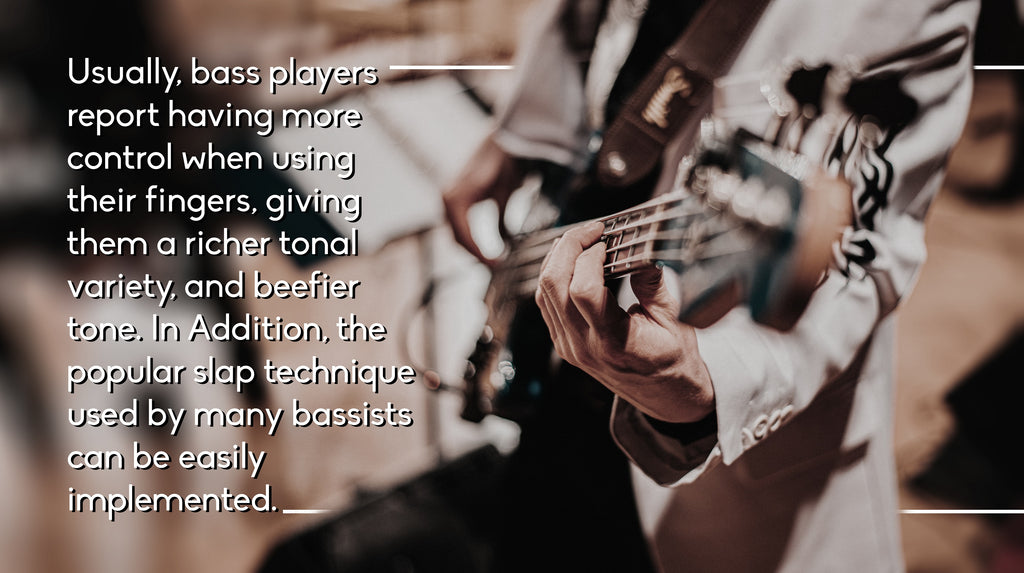
A funny positive argument is, that you will never lose your bass pick if you don’t own one.
One of the drawbacks of this method is that it takes a little more work to learn. Nevertheless, if your goal is long-term learning, this should not be a technical obstacle.
Using Picks to Play Bass
The biggest advantage of using a pick for the bass guitar is obvious: Instant speed. You can develop speed more quickly and effortlessly.
If the bass lines you want to learn, belong to certain music styles that are speed intensive, a pick might make sense. You can develop the same speed as with your fingers, but it will take much more time.
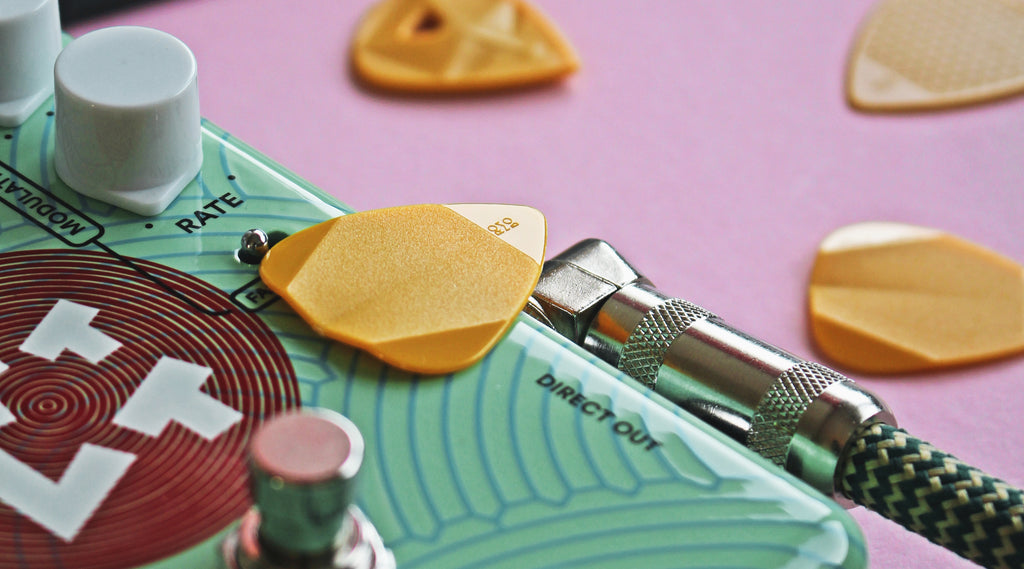
In addition, the tone can be easily changed by using a different guitar pick. This allows you to have different tones, and experiment a lot to find the right sounding bass guitar pick.
Every pick - for guitar, bass, or other instruments - has four different main parameters: Shape, material, thickness, and size. Combined together, they result in a very specific range of tone textures, attack soundwaves, and feedback. Therefore, choosing your guitar pick is one of the most difficult tasks. We have created a guide HERE, that will help you find your tone.
Pick Thickness for Bass Players
Bass players generally use thicker picks. The thickness improves the bass playing control, and the overall tone of the string.
The average pick thickness for bass players is 1.17 mm, while for guitar players is 0.89 mm. Remember, bass strings are much thicker than guitar strings. Therefore, a thinner plectrum will give you much less control in comparison to a thicker plectrum.
The size of the pick will also have a role in the creation of the tone.


Having said that, there are still many bassists who do prefer to use thinner bass picks, like for example Rombo Classic, or Rombo Origami.
If you have no idea where to start, take the average value and look for picks with a gauge of about 1.2 mm. This is a good place to get started. From there, you can go up and down and try other picks depending on your preferences. It might be a good idea to look for the bass picks your favorite players use, and try to understand why they do so.
Most Popular Pick Shapes for Bass:
The truth is, most classical shapes tend to have an excellent reception between the bass players.
The most popular shapes are the classical teadrop pick shape, the rounded teardrop pick shape, and the triangle pick shape.
In addition to shape, there are many other attributes that define a pick. HERE you can read about the 6 most underrated attributes of guitar and bass picks.
Teardrop
Teardrop is the most popular and known type of guitar and bass pick. Semi-sharp point for quick attacks, that maintain a wide range of possibilities, depending on the thickness and material used.
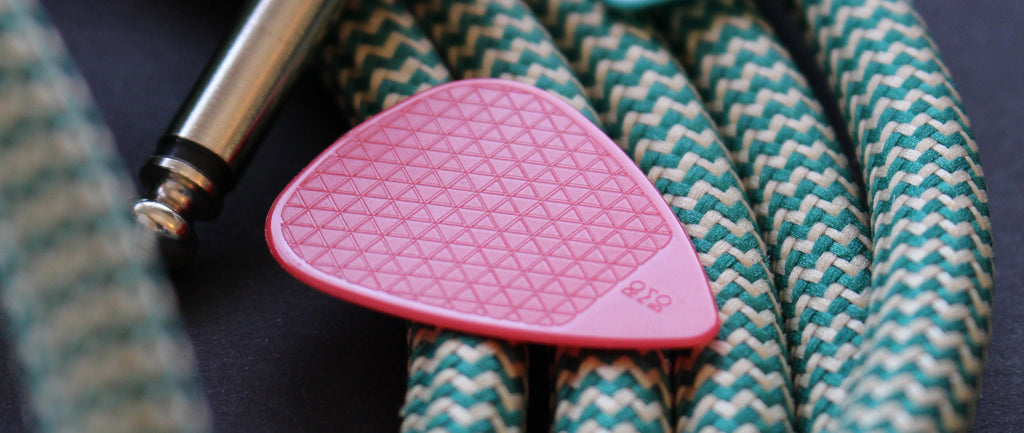
Rounded
Rounded picks provide a more warm sound and smooth attack. These are for the bass players looking for a way to play the bass strings with less force and attack. Sometimes they are totally free when a teardrop pick is completely worn down.
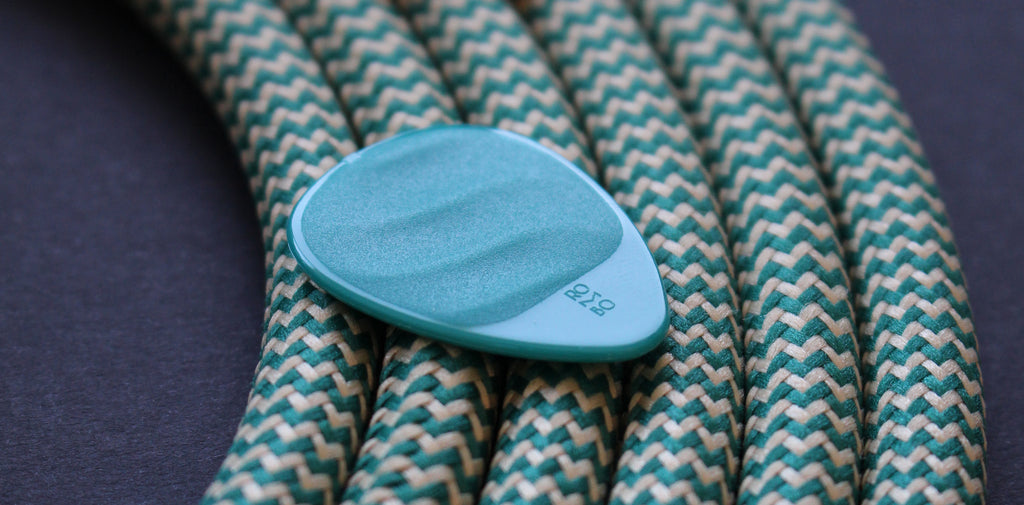
Triangle
A triangle pick is the most practical option because of the tri-sided feature. You can pluck your string with any of the three pointy tips this pick provides. A triange pick is recommended for those players who constantly break the tips of their picks.

Pick Materials for Bass Players:
When it comes to bass, we apply the same rules as with guitar picks.
After studying the physics of guitar picks, and all the material possibilities we have, we came to the following conclusions. The pick material should:
- feel nice to the touch and be comfortable, yet provide grip
- be able to create clear tones, without compromising the bass tones
- be very versatile: feel flexible when thin, and feel stiff when thick
- be durable
- look nice

You can read all about materials used at Rombo HERE.
You will also find a link with the information about Eco-Black - These picks made out of 100% recycled fibre waste, that we manufacture ourselves.
The durability of Bass Picks:
Because the strings are thicker, and bass players tend to play with more energy, the lifetime of your pick will be substantially reduced.
A way to reduce the wear and tear of picks for bass is:
- Using thicker picks
- Using harder materials
- Using picks with polished tip
- Using triangle picks (3 tips take longer to wear down).
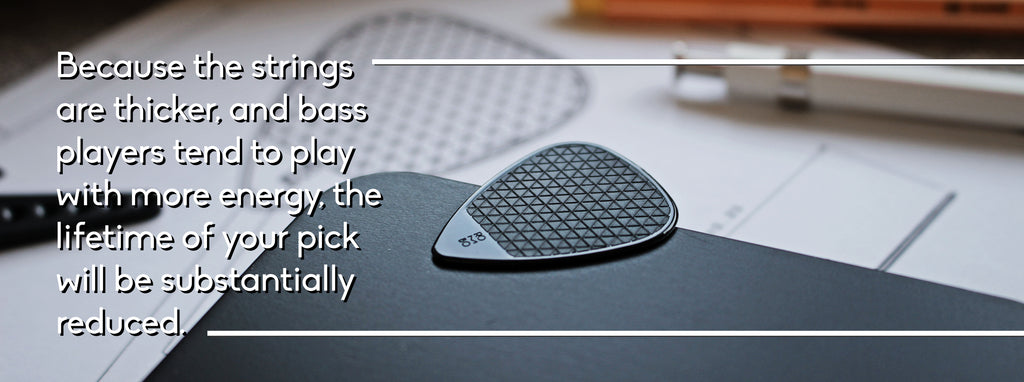
Conclusion:
Playing bass with a pick is as valid as using your fingers, if this is the tone you are looking for.
Finding a pick you are comfortable with, is a difficult task, but testing lots of them and recording some of your bass lines can help you find a balance between the tone you want, and the feel and feedback you wish from the pick.
In picks, qualities like thickness, material, shape, and size play a pivotal role in tone, feedback, grip, pick noise, sustain, etc... Music is about staying dynamic and monotony kills dynamic. Therefore, the most logical step for you is to explore enough to understand as many aspects of the bass as possible.
This applies to guitar gear in general (including picks, strings, cables, etc...) and your practice habits, style preferences, and your own psychological bias/barriers.
Sometimes the best place to start is testing a Variety Pack


How To Hold A Guitar Pick
In case you are trying to learn the guitar, the first thing you need to know is how to hold a guitar pick the right way.
Guitar pick or plectrum is a small object that you hold in your hands and play the guitar strings. The quality of guitar you are playing depends mainly on the way you are holding its pick.
So, before you officially start learning guitar, you should learn to hold the plectrum in the right manner.

Mentioned below in this article are some of the tips and tricks which you can use for holding the guitar pick in your hand so that it doesn’t feel awkward and helps you in playing the guitar in the most suitable way.
Holding A Guitar Pick
The first and the easiest manner of holding a guitar plectrum is that you keep it in between your index finger and your thumb. Hold it in a way that it fits tightly in between your fingers. Now keep the position of your in such a manner that it can easily brush all the strings of your guitar.

As while playing, you will have to move the plectrum all over the strings and in order to be able to play guitar perfectly, the plectrum needs to touch all of the strings easily.
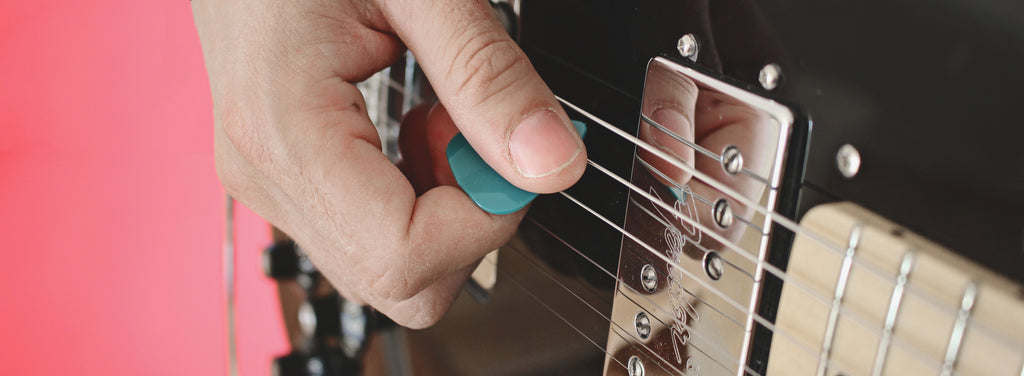
One thing that you need to keep in mind is that there are a lot of different types of plectrums available in the market and you should choose the one that works best for you. Once you have chosen the perfect pick, try to practice with it as much as possible.
We created a four-step guide to choosing your guitar pick, which you can find here:
https://rombopicks.com/blogs/insight-rombo/how-to-choose-the-right-guitar-pick
Brush it against the strings of your guitar so that your hands move easily and it produces a sound.
More Methods For Holding A Plectrum
Another technique that you can use to hold a guitar pick in your hand is that you keep it in your dominant hand. This is the hand that you use the most, so it will be easier for you to keep the plectrum in it and play the guitar.
Some people prefer to play the guitar chords with the hand that they don’t use more often i.e non-dominant. So by holding the plectrum in your dominant hand and controlling the chords with no dominant one, you can easily brush the guitar strings and produce music.

Now place your one hand on the neck of the guitar and hold the plectrum between your index finger and thumb of the dominant hand. Keep in mind that the strings of your guitar are facing away from you. Keep the guitar on your knees, as for a beginner, it is easier to play the guitar while sitting. But in case you want to play standing up, you can use a shoulder strap so that it is easier for you to control.
Keep your hand steady but flexible. Steady because you need to hold the guitar plectrum and flexible because you need to keep brushing it over all of the strings.

A good sound will only be produced if you are moving your hands the right way. Keeping them too rigid will result in an unpleasant sound which no one likes to listen to. But once again, keep in mind that a good sound can only be produced after practice.
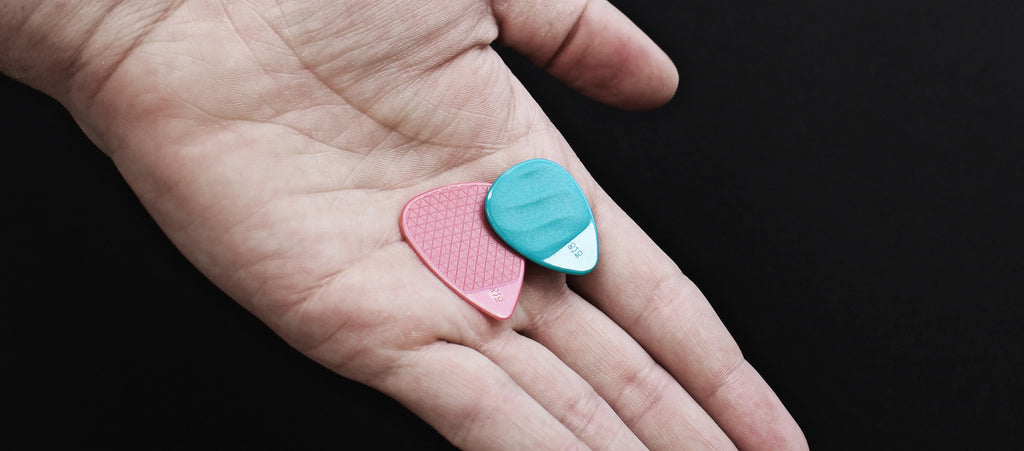
During the initial times, you only need to focus on getting your hands used to the guitar. So that it knows where the strings are, which chords to play and where to keep the plectrums. These are the basic skills that everyone needs to learn before officially starting out various tunes on the guitar.
For those more advanced guitarists looking to improve their guitar playing speed, click HERE.
Things To Keep In Mind
Once you are in your comfortable position, rest your hand holding the plectrum on the strings of the guitar. Keep in mind that your hand should cover at least half of the plectrum. Some of the picks are made in a way that they are folded from one side to easily fit your index finger and your thumb on it.

Here you can find an example: Rombo Origami
Keep the grip of your hand as firm as possible but make sure it is easily movable so that once you start playing, you can brush the strings without making any extra effort. Never loosen your grip on the plectrum because it might fall off your hand while playing.
More Things To Focus
Now if you are a beginner, it is good that you are trying to get as much help as possible because this will help you in becoming a good guitarist within a minimum amount of time. By now, you do know how to carefully hold a plectrum (i.e between your index finger and thumb) now rest it over the strings.
Keep in mind that it should just lightly brush them so that only placing it there doesn’t produce any sound. The sound of your guitar must only be produced once you are moving the plectrum all over the strings.
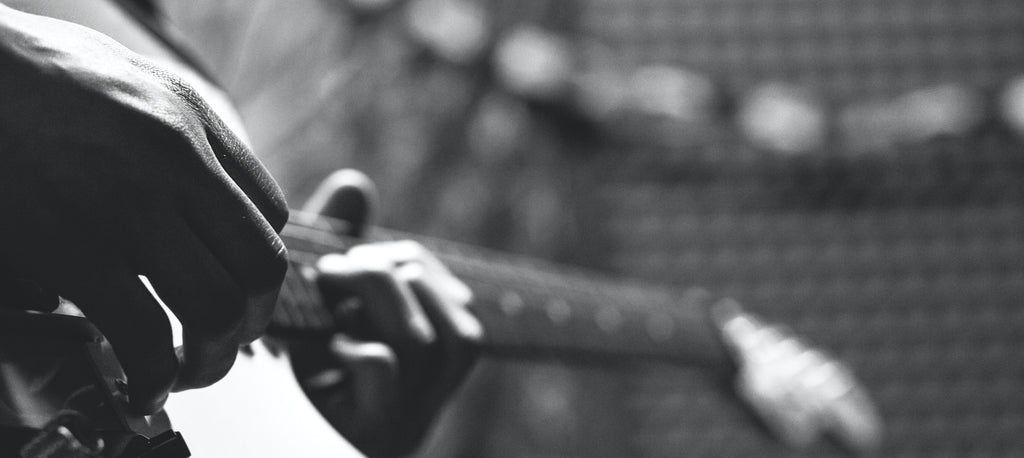
One side of the strings is thin while the other one is thicker, practice on your guitar by gently moving your hand from the thicker side of the string to the thinner one. Although during the initial stages, rhythms produced would be rough but don’t worry about it. As you are only learning to hold the plectrum in the right way. There is a lot of time for learning guitar but prior to that, practicing is the most important thing that you need to do.
As this is the starting phase, try to practice as much as possible. As practicing will not only make your hand steady but it will also help you in maintaining your physical strength. The more your practice, the better you will be at playing guitar.
All successful guitarists need to play for hours in front of their audience and a person is only able to do that if he has done enough practicing.

So, in case you are taking more time trying to hold the guitar plectrum in the right way, tune the string or adjust the strap, don't worry about it. As all the great guitar players have started from this exact step so just polish your skills and you too will be an amazing guitarist really soon.
Note: There are many annoying things in life, but there’s nothing more annoying than losing a guitar pick you just had in your hand, and then realize that it has disappeared forever! - 4 Tips To Not Lose Your Guitar Picks
The Guitar Picks We Use Impact How We Play
If your hands do an arduous job, then you must give them the right tools, right?
The material with which it is made can influence the definition of tone, attack, and flexibility. Therefore, without paying attention to it, you could hardly find your personal sound.
Are you curious about the materials used for the Rombo guitar picks?
Read a full article about it here:
https://rombopicks.com/blogs/insight-rombo/guitar-pick-materials-at-rombo

Guitar Pick Materials At Rombo
Guitar picks can really be made out of anything. In the past, some exotic materials were used to produce guitar picks.
The technological wave that came with highly specialized polymers created a new era of materials with amazing properties.
How The Material Of A Guitar Pick Influences Your Playing
The material of a guitar pick is strictly connected to its flexibility and tone. It is hard to imagine that such a small piece can have a big impact on playability.
However, you will clearly notice some sound differences when testing a couple of different guitar picks.
Luckily, these small useful gems are the cheapest guitar accessory you can acquire, allowing you to test many guitar pick models.

The Constant Search For The Perfect Tone
When it comes to guitar picks, changing the properties of a material is not an easy task.
Flexible guitar pick materials:
Flexible guitar pick materials can create mellow and warm tones when using specific guitar techniques. However, they can also achieve brighter tones when holding the pick very closely to the pointy tip or “attack area”. This is the reason they have been the go-to choice for guitarists for decades.
Stiff guitar pick materials:
Stiff guitar pick materials can create a snappier, bright tone that can be very delightful, provide more volume and more clarity to your chords and solo notes. These picks are often used for more specific guitar techniques by lead guitarists.
Material Isn't Everything
Thickness, shape and size will play an important role too!
Flexible guitar pick materials can create mellow, warm tones. However, when using plectrum thicknesses over 1 mm, the tone will get darker and heavier. This can be used to create the feeling of having more “bass” in your instrument. The same effect happens with the size. The more material you have, the heavier the sound will be.


We have a guide to find your guitar pick HERE. You will learn how these 4 attributes (material, shape, size, and thickness) are connected.
Finding The Materials For Rombo Guitar Picks:
Every guitarist has different preferences. Throughout our development, we have involved as many professional guitarists as possible, and asked them to define how their perfect material should feel.
We came to the following conclusions. The guitar pick material should:
- feel nice to the touch and be comfortable, yet provide grip
- be able to create clear tones, without compromising the bass tones
- be very versatile: feel flexible when thin and feel stiff when thick
- be durable
- look nice
With these premises, we started our long journey: the search for a suitable material.
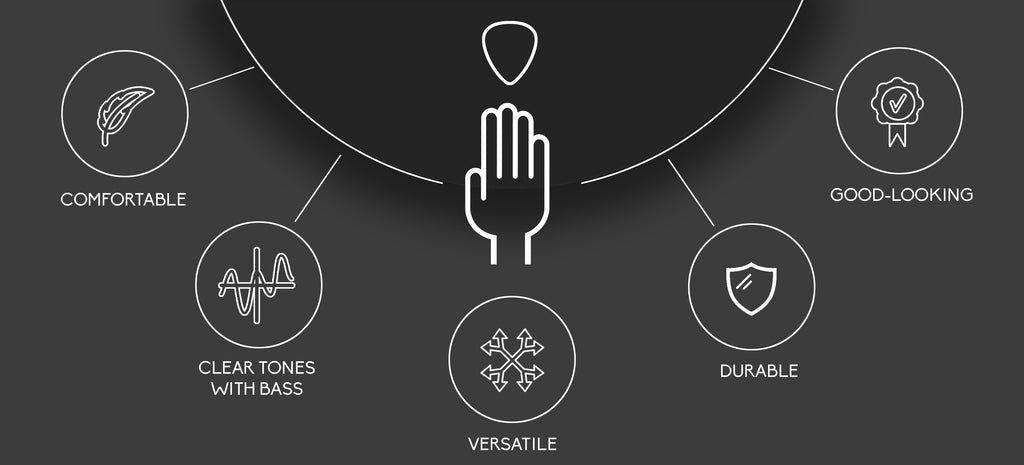
After lots of tests, feedback rounds and sending dozens of pick prototypes around the globe to our guitar pick testers, we think we`ve found it!
Guitar Pick Materials At Rombo
We are using a thermoplastic polymer that belongs to the family of the polyamides. This material is used in aerospace and automobile industries and has the following properties:
- High-mechanical strength
- Versatile (rigid or flexible -depending on the treatment and thickness)
- Excellent impact resistance (guitar strings)
- Superior aesthetic properties
- Medium / low friction
The raw material we use is produced in Italy. We have worked very closely with our material partner to accomplish every requirement we had, including the 100% recycled material of the EcoBlack sets.
We believe we have achieved an excellent balance between, sound, comfort, aesthetic properties, and durability.
Combined with well-thought ergonomic designs, different textures, and very good quality control of the process, this material can accomplish all 5 premises we defined above.


Eco-Black Range: 100% Recycled Guitar Picks
We are also experimenting with recycled materials. In our “ECO-Black" range, we offer the same material formula, but use 100% recycled material from pre-consumer waste.
In this product range, the guitar picks are only available in Graphite Black. Currently, this is the only color we can produce when using this compound.

In addition, during compound manufacturing, there are 90% less emissions, 65% energy reduction, and a 61% reduction of total resources.
We will continue our hard work in this area and someday in the future, we will be able to create colored guitar picks out of this material. When this day comes, all of our guitar picks will be 100% recycled.
Read more about the Eco-Black range and the recycled guitar picks in our article "ROMBO Unveils New “Eco-Black Range Guitar Pick Models".
Conclusion:
Finding a material you feel comfortable with is not an easy task, but you will have lots of fun along the way.
We believe material development is fundamental to ensure a future of plenty of functional, good-looking and environmentally friendly materials.
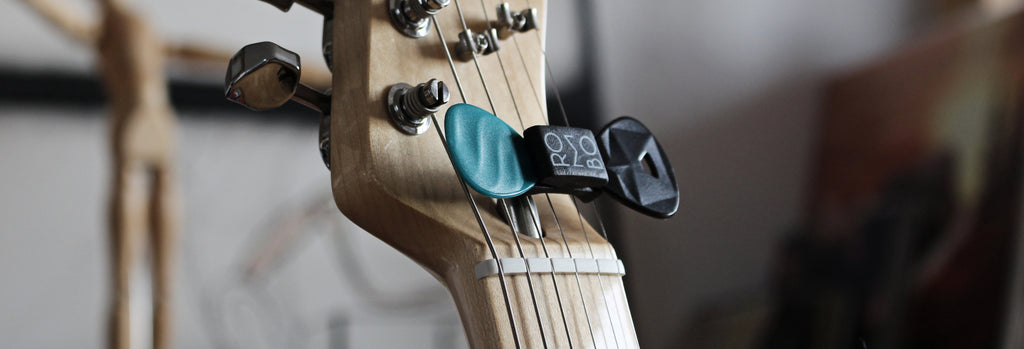
Did you find this information useful?
Share this article with friends to help us with our mission: vote for development, for the implementation of new ideas and for questioning deep-rooted standards to find something better.
Thank you!

Guitar Pick Grip: Why Textures On Guitar Pick Surfaces Can Help Improve Your Playing Experience
The surface of a guitar pick is in direct contact with your fingers. You feel it when you hold your pick, and your guitar strings will touch the surfaces every time you play a chord or a guitar solo.
Textures on guitar picks define not only important things like grip, control, and friction between the strings and guitar pick, but also equally important details like comfort, pick noise, and design.

Why Should The Different Areas Of The Guitar Pick Have Different Texture Types?
The guitar pick consists of two areas: The hold area (body), and the attack area (tip).
Both areas have different requirements. Generally speaking, when combining the proper textures of these two areas, a guitar pick should offer:
- a comfortable surface to hold the pick securely
- a well-designed tip to promote precision

With this simple fact in mind, it seems logical to differentiate these two areas when it comes to choosing the texture of the guitar pick.
Guitar Pick Hold Area:
The body of the guitar pick is the part of the plectrum, which you use to hold it.The textures on the body will directly affect:
- the control of the guitar pick
- the grip of the guitar pick
- the comfort of the guitar pick
These three features are strictly connected and every guitar player will have a very subjective opinion of them.
Guitar Picks With Grippy Surface:
These are specifically designed guitar picks. These guitar picks won’t slip so easily and the texture on the hold area will provide the guitar player with enough grip.
Advantages Of Guitar Picks With Grippy Surfaces:
-
Control the position of the pick between your fingers: avoid rotation and pick slippage.
-
Hold the pick with less tension, which results in a better playing experience and less hand fatigue.
Common Types Of Grippy Guitar Picks:

-
Sandpaper grip: Maximum grip, very aggressive texture (uncomfortable for long playing sessions)
-
Raised geometries or logos: High grip, aggressive texture (can feel uncomfortable for long playing sessions).
-
Micro-nodules texture: Medium/High grip, comfortable texture (the micro-nodules fit between the grooves of your skin). Read more here.
-
Grip Holes: Medium Grip
-
Homemade guitar pick grip: Some players use tape or make scratches on the pick to create a custom experience.
It is up to you to find a balance between comfort and grip. Some players prefer non-sticky guitar picks, some others need the maximum grip available.
The best thing you can do is try all different textures and decide yourself, considering the playing style you have.
For guitar sessions for over 1 hour, I prefer comfort over the grip. Once you get used to the guitar pick and how it reacts after every impact, you appreciate the comfort more and the playing experience texture and design can give you.
Guitar Pick Attack Area:
The texture on the tip of the plectrum will have a direct influence on:- Durability
- Pick Noise
The texture on this guitar pick area is one of the most undiscovered features in the guitar pick world. Read more here.
How can a polished guitar pick improve durability and reduce noise?
Actually, it is very simple: A mirror polished guitar pick will reduce friction between guitar pick and strings. With every impact, the guitar pick will suffer less friction and therefore wear down slower.
With less friction, the pick will cause less pick noise. From my own experience, guitar picks with this attribute make me want to play forever.
In addition, the pick will glide better and provide a better playing experience. However, this is a very subjective point since other types of guitar picks with coarse textures on the tip are very popular amongst some guitarists. Pick noise is sometimes wanted when strumming chords.
Bonus Feature: Unique Designs:
This is a bonus argument I always use: Combining different textures in one pick can be very useful for creating unique designs.Guitar pick surfaces not only affect the function, but also the aesthetics.
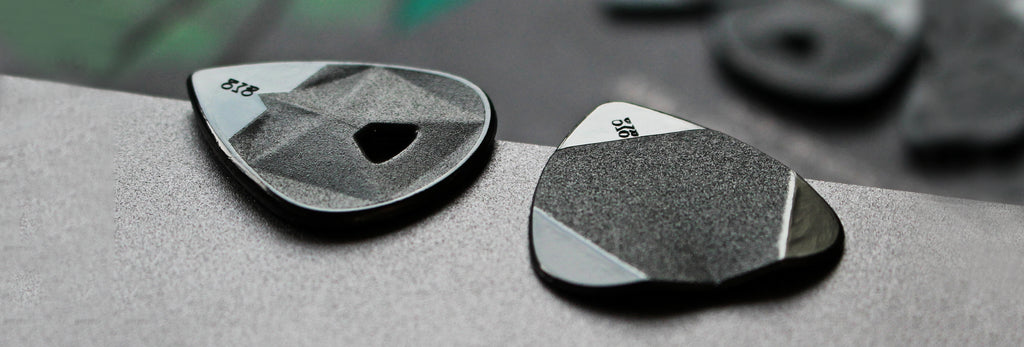
In order to build your own image, you need gear that fits in it. Design is as important as the other aspects when it comes to music gear.
Fortunately, we live in an era where many brands are creating very original designs with the best functionality.
Guitar Pick Grip: What Textures Are We Using At Rombo?
We believe textures on guitar picks are essential for a tool that was designed to be held between your fingers
The combination of two different surface finishes in the guitar picks have convinced us and our testers of the potential gains a player can achieve:
- A polished tip for clarity, durability and control
- A micro-nodules texture in the centre of the guitar pick for the most comfortable holding without compromising grip
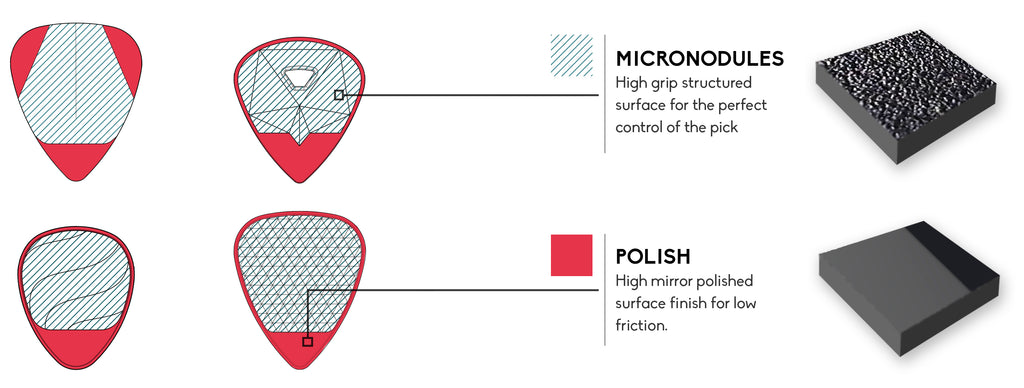
Conclusion:
Grippy textures can help you hold the guitar pick more firmly without effort.
Looking for a texture you feel comfortable with is essential to find the balance between grip and comfort.
However, what about thickness, shape, size, and material? Have you thought about these attributes?
Learn more in our article "How to choose the right guitar pick".


So wählst du das richtige Plektrum in 4 Schritten aus
Was sind Gitarrenpicks?
Gitarrenplektren sind die Brücke zwischen dir und deinem Instrument. Ein versteckter Held in den Händen von Gitarristen.
Ein Plektrum ist ein sehr persönlicher Gegenstand und die Wahl des besten hängt von mehreren Faktoren ab. Es gibt kein magisches Plektrum, aber jeder wird sich mit einem Plektrummodell anfreunden, den er mag und genießt.
Um das richtige Plektrum auszuwählen, müsst du einige sehr grundlegende Konzepte verstehen.

Welchen Unterschied kann ein Gitarrenplektrum wirklich machen?
Das Plektrum beeinflusst nicht nur Ton und Technik, sondern auch andere Aspekte wie Attack (die Art und Weise, wie dein Plektrum auf die Gitarrensaiten trifft) und Ergonomie (die Kontrolle, die es während der Übergänge zwischen den Saiten bietet).
Das Verständnis einiger Grundregeln ist bei der Auswahl des richtigen Plektrums unerlässlich:
SO WÄHLST DU DAS RICHTIGE PLEKTRUM
1- Form des Plektrums
Die Form der Spitze ist ein Faktor, den die Spieler oft übersehen. Die meisten Menschen werden dazu neigen, sich nie von der Standardform zu entfernen, die wir alle kennen und lieben. Die Form des Plektrums beeinflusst, wie einfach es zu halten ist und wie genau Sie mit Ihrem Picken umgehen können.
Helle Töne werden mit einer spitzen Spitze erzielt, warme und weniger definierte Töne werden von Plektren mit abgerundeter Spitze erzeugt (wie in der Abbildung unten zu sehen).

Extra-Tipp: Zusätzlich kann eine abgeschrägte Kante (beveled edge) an der Spitze mit abgerundeten Kanten dazu beitragen, eine gleichmäßigere Saitenreibung zu erzeugen, was zu effizienteren Schlägen und Geschwindigkeit führt.
2- Dicke des Plektrums
Die Dicke deines Pleks ist der wichtigste Teil davon, wie hell oder wie warm die Gitarre klingt. Wie bei allem haben die verschiedenen Optionen für die Dicke des Plektrums jeweils ihre eigenen Vor- und Nachteile.
Die Dicke eines Plektrums hat auch den größten Einfluss auf die Flexibilität (wie in der Abbildung unten zu sehen).

Die Dicke von Gitarrenplektren wird im Allgemeinen in Millimetern (mm) gemessen und die Bereiche variieren stark je nach Marke und Musikstil:

Dünne Plektren:
Gut für Rhythmusgitarre, aber nicht so toll für Leadgitarre wegen der fehlenden Kontrolle beim Spielen einzelner Noten. Es biegt sich leicht, wenn es mit den Saiten in Kontakt kommt, und ist ideal für Anfänger. Es liefert immer einen Sound, der flüssig erscheint.
Mittlere Auswahl:
Die vielseitigsten Gitarrenplektren und perfekt für Sologitarristen, die verschiedene Techniken in denselben Songs verwenden (Strumming, Solo, Palm Mute usw.…). Sie kombinieren Komfort, Präzision, Rhythmus und Spielgeschwindigkeit.
Dicke Plektren:
Dicke Plektren geben dem Gitarristen mehr Kontrolle über die Lautstärke und den Attack auf die Saiten. Favorit unter fortgeschrittenen Gitarristen. Die Leute entscheiden sich für diese Art von Dicke, weil sie Präzision für ihr Spiel auf hohem Niveau und ihre Soli-Parts benötigen. Garantierte Spielgeschwindigkeit!
Extra-Tipp: Einige Plektren mit variabler Dicke (unterschiedliche Dicken im Haltebereich und Angriffsbereich) können helfen, diese Eigenschaften zu kombinieren, indem sie einen starren Körper und eine dünnere, flexiblere Spitze bieten.

3- Die Gesamtgröße des Plektrums
Die Größe des Picks ist der größte Faktor bei der Betrachtung des Komforts. Dies ist bei jedem individuell, weil niemand gleich ist. Außerdem ist dieser Punkt eng mit der Form des Plektrums verbunden.
Du wirst vielleicht feststellen, dass kleine Plektren leichter fürs Shredding sind und mehr Geschwindigkeit erzeugen. Deine Finger sind näher an den Saiten und du spürst besser, was du spielst. Der Nachteil dieser Picks ist, dass sie leicht fallen gelassen werden können, da sie kleiner sind.
Du könntest auch feststellen, dass größere Picks einfacher zu halten sind und sich komfortabel anfühlen. Experimentiere mit verschiedenen Größen und verwende, was für dich am bequemsten ist.
Normalerweise variiert die Größe zwischen 15 und 40 mm (wie in der Abbildung unten zu sehen).

Einige Gitarristen bevorzugen große Plektren, weil sie durch die Vergrößerung der Kontaktflächen einen besseren Halt bekommen.
4- Materialien und Texturen für Gitarrenpicks
Gitarrenplektren können wirklich aus allem hergestellt werden. In der Vergangenheit wurden einige exotische Materialien zur Herstellung von Gitarrenplektren verwendet.
Die technologische Welle hochspezialisierter Polymere hat eine neue Ära von Materialien mit erstaunlichen Eigenschaften geschaffen. Normalerweise sind dies die Haupteigenschaften, die ein gutes Material haben sollte:
- Hohe mechanische Festigkeit und Steifigkeit
- Hervorragende Schlagfestigkeit
- Hervorragende ästhetische Eigenschaften
Extra-Tipp: Grifftexturen hängen auch vom Material ab. Eine Mikronoppenstruktur auf einem Plektrum kann zusätzlichen Halt bieten, ohne die Finger zu verletzen. Mehr dazu in unserem Artikel „Warum Texturen auf Plektrumoberflächen dein Spielerlebnis verbessern kann“

Zusammenfassung:
Der einzige Weg, um dein Plektrum wirklich zu finden, besteht darin, einige Zeit damit zu verbringen, neue Formen, Materialien und Größen auszuprobieren. Manchmal ändern sich deine Bedürfnisse als Gitarrist mit der Zeit. Die Wahl, die du zu Beginn deiner Karriere getroffen hast, ist möglicherweise nicht die, die du jetzt für dein Spiel benötigst.
Die Entwicklung deiner Fähigkeiten bedeutet auch, sich an neue Umgebungen anzupassen. Es ist bewiesen, dass das Spielen mit neuen Gitarren und neuen Gitarrenpicks helfen kann, deine allgemeinen Fähigkeiten zu entwickeln und dein Gehirn flexibel zu halten, wodurch es zu einem kontinuierlichen Lernen wird. Keine Angst vor Abwechslung.
PS: Hast du darüber nachgedacht, recycelte Materialien zu verwenden? Erfahre mehr in unserem Artikel: „Rombo stellt neue „Eco-Black Range“-Gitarren-Pick-Modelle vor“

ROMBO Unveils New “Eco-Black Range” Guitar Pick Models
Guitar Picks Made Out of 100% Pre-consumer Fibre Waste
Rombo Picks has unveiled a new series of plectrums made out of 100% recycled waste. The material is not only environmentally friendly, but also has high mechanical strength and stiffness, excellent impact resistance and superior aesthetic properties.

Rombo uses this material for its Eco-Black range. In this range, all four guitar pick models are available only in Graphite Black, which is one of the properties of the recycled material. Each pick has been carefully developed for a concrete purpose.
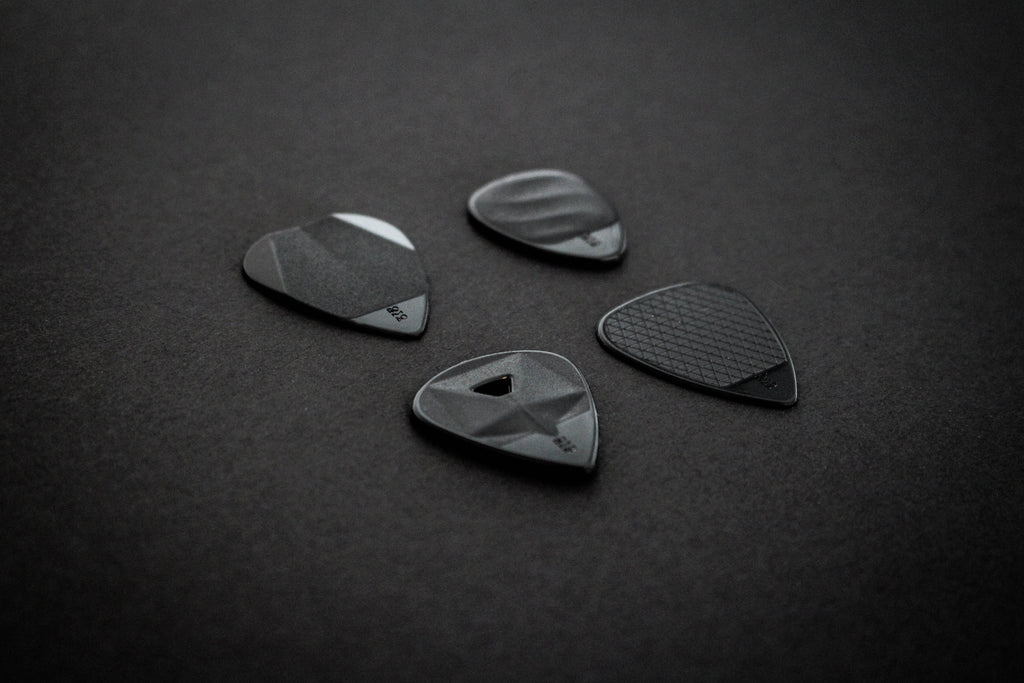
For this reason, the Rombo team has redefined the four attributes of a guitar pick: shape, thickness, material and size.
The Highlights of These Guitar Picks Are:
- Micro-nodule grip structure
- High mirror polished tip
- 3D ergonomic design surface
- Variable thickness
- High-Quality materials
- Unique designs

Since 2019 Rombo has been researching surface finish and design in order to find the perfect balance between grip, ergonomics and function in guitar picks. Rombo was born thanks to an amazing guitar player community whose aim is to continue this adventure and quest for the perfect guitar pick.
We have a full article about the materials used for the manufacturing of the Rombo guitar picks here:
https://rombopicks.com/blogs/insight-rombo/guitar-pick-materials-at-rombo
Did you found this article useful? Please share it with your friends!
Do you think these features are important attributes for guitar picks?
What do you think about the material we are using for this range?

Music and DIY generation
When it comes to music there are two eras: Before the Internet and after the Internet. The Internet has changed music forever. In just a few years, the old industry model has changed rapidly.
While the biggest labels had to rethink their structures and question the basics of their business, the DIY generation saw this new world as an opportunity. A chance to create, find new tools, share knowledge and destroy all the borders, permanently.
There were no radio-formulas anymore, there were no limits for defining styles and the best of all; everyone now has access to everything.
Some artists have realized they were the ones controlling their destiny, and that the possibilities were endless.
You would see artists managing different projects simultaneously: This allowed lots of them (us) to take risks and as a result, some of them went viral. YouTube and streaming portals became the new way to listen to music and the musicians could upload their new songs to their own channels: Bands are closer than ever to their fans.
We know more about our icons than ever before. Besides this, the technology has also played an important role here: People who do not have access to professional recording studios can now learn by themselves how to create music with their computers, which are getting cheaper and cheaper. Some companies are specialized in creating audio samples: for example from real studio drums, guitars or synths.
They sell these samples and you can use them to make your tracks sound better. You don’t need thousands of dollars to record your demo, just a laptop and a middle-class microphone you can get second-hand on eBay.
People have gotten very organized and have started to share all this information in music forums, for free.
The underground scene has been growing ever since the Internet got popular. It has never been so strong and this pushes the music-makers to be more creative and diverse.
The DIY generation musicians write their own rules and guidelines. They define the sound of today and will leave their imprint on the next generation.
Why This is Important to us:
We belong to this generation; we grew up with this movement, which set the basics of our personal culture.
Creating Rombo was a great idea in many ways and wasn't a happenstance, but an inevitable consequence of our motivation for creating new things: We have learned by ourselves, or rather; we had to learn by ourselves, and that is such a joy!
We all had our bands or projects and spent hundreds of hours composing new tracks, creating the designs for our own covers, drawing the poster designs for each show and then evaluating every new idea.
It feels really good when someone discovers your project and says, "thank you for creating this!" It feels really good to discover awesome projects on Bandcamp or Kickstarter.
These people believe in DIY, and so do we. These people have fun, and so do we.
Folge uns
Judith Heindorf & Carlos Diez Macia GbR
Auf der Steige 29
71686 Remseck am Neckar
DEUTSCHLAND
- Shop
- Händler
- Impressum
- AGB
- Widerrufsrecht
- Versandbedingungen
- Datenschutzerklärung
- Kontakt
- Presse
- Fragen & Antworten
Melde dich zu unserem Newsletter an und erhalte alle Neuigkeiten zu Sales, Neuerscheinungen und vielem mehr…
Mit der Anmeldung stimmst du unseren Datenschutzbedingungen zu.
© 2025 ROMBO.
ist eine registrierte EU-Marke.
Wir nutzen Shopify.




